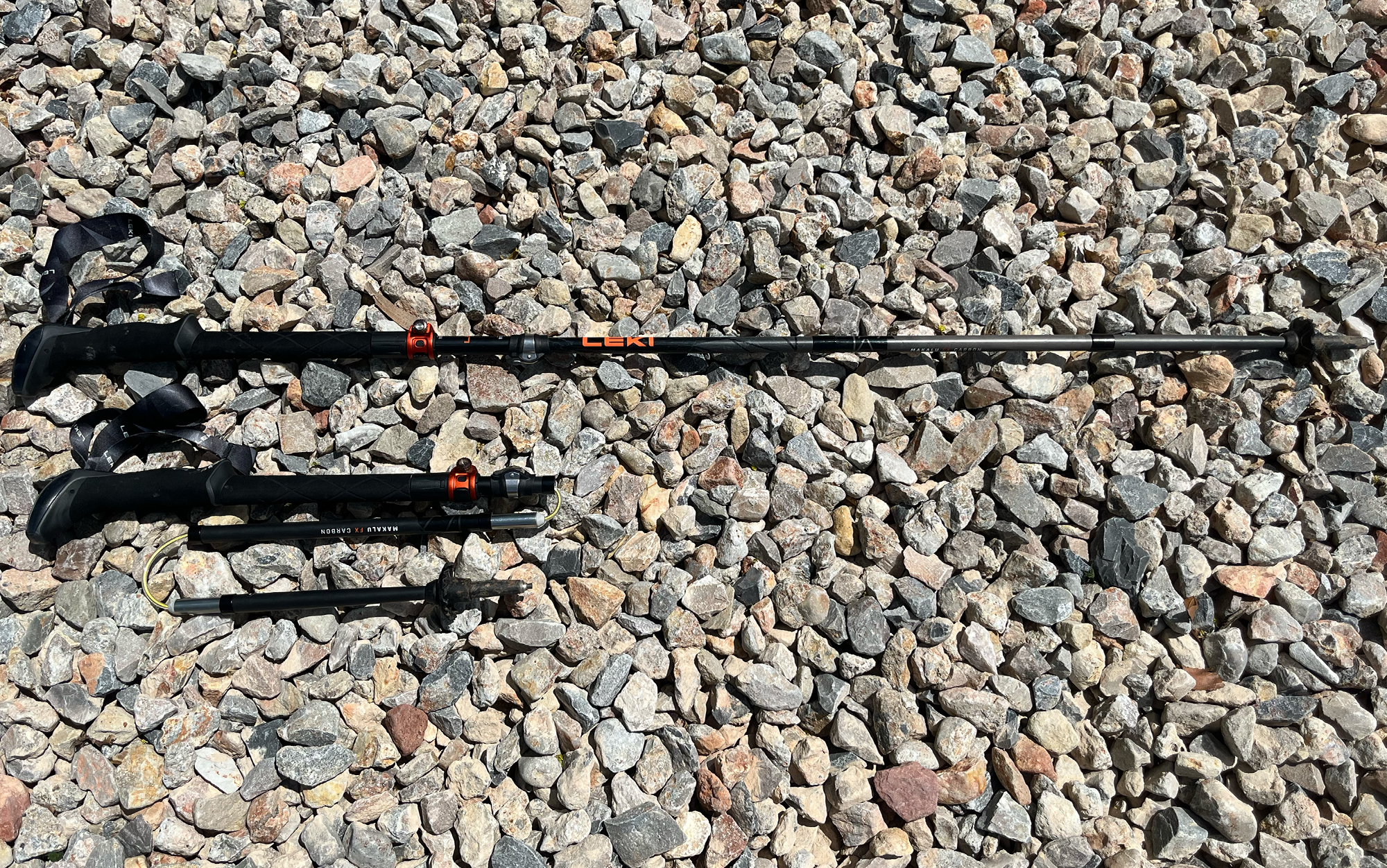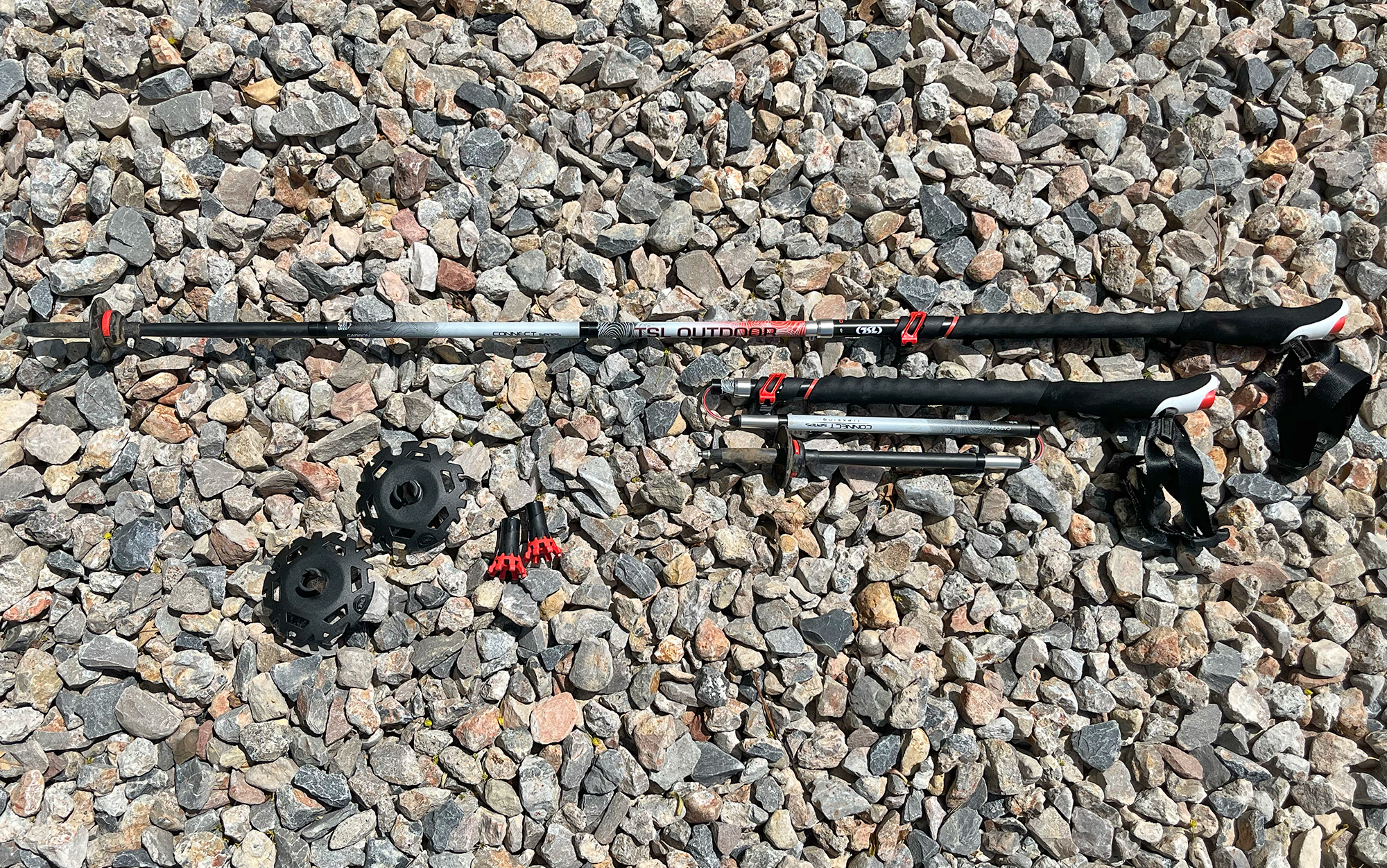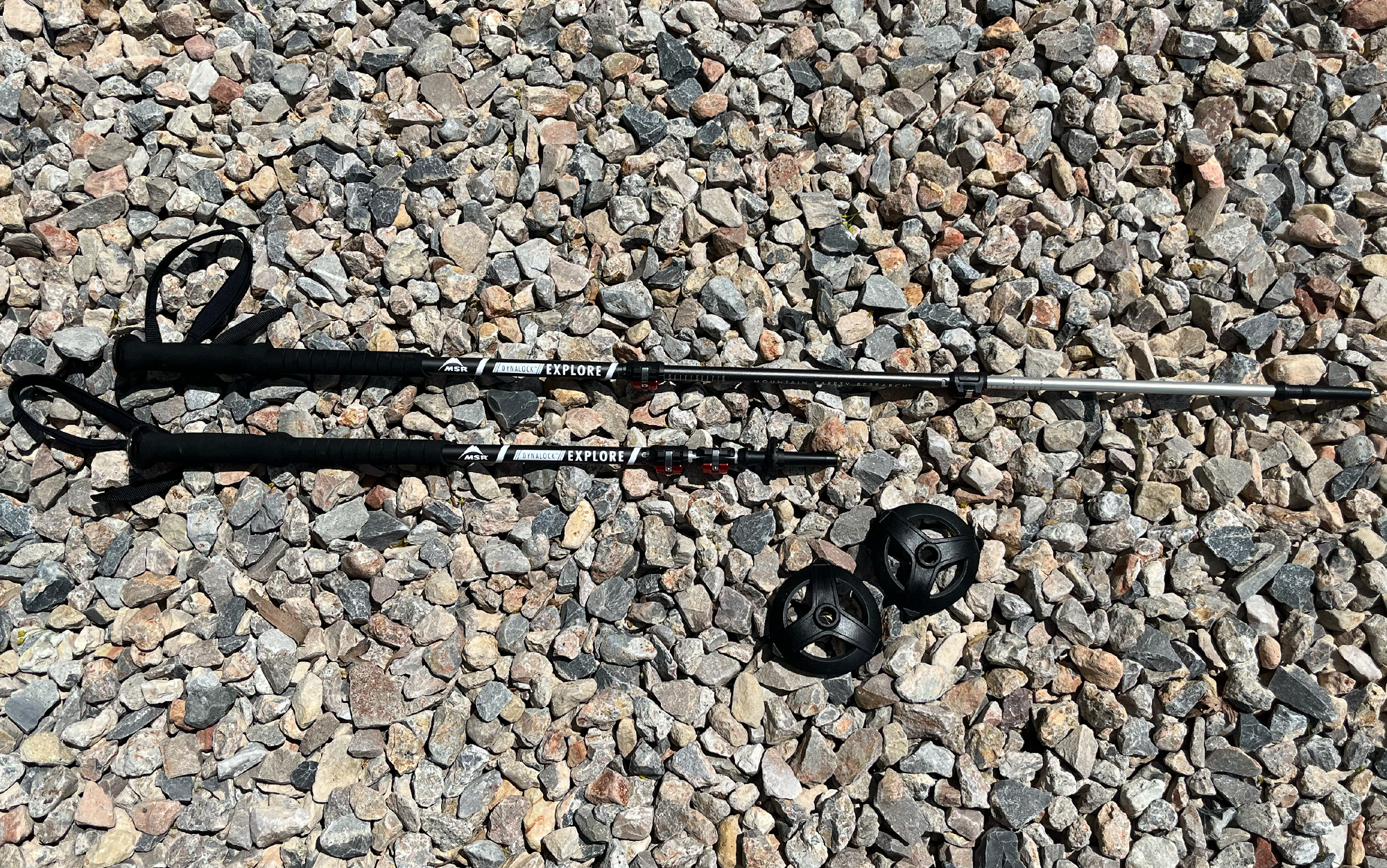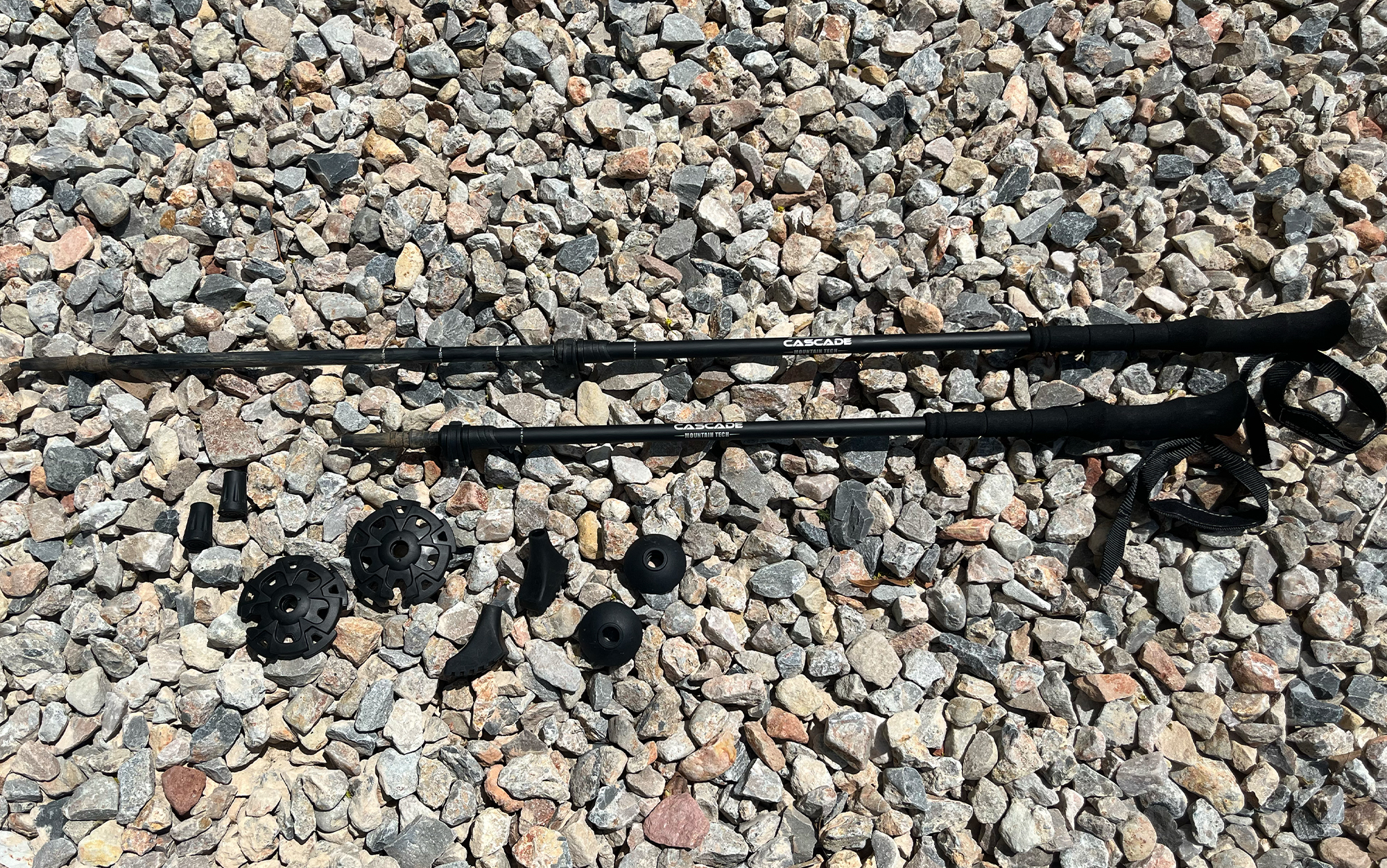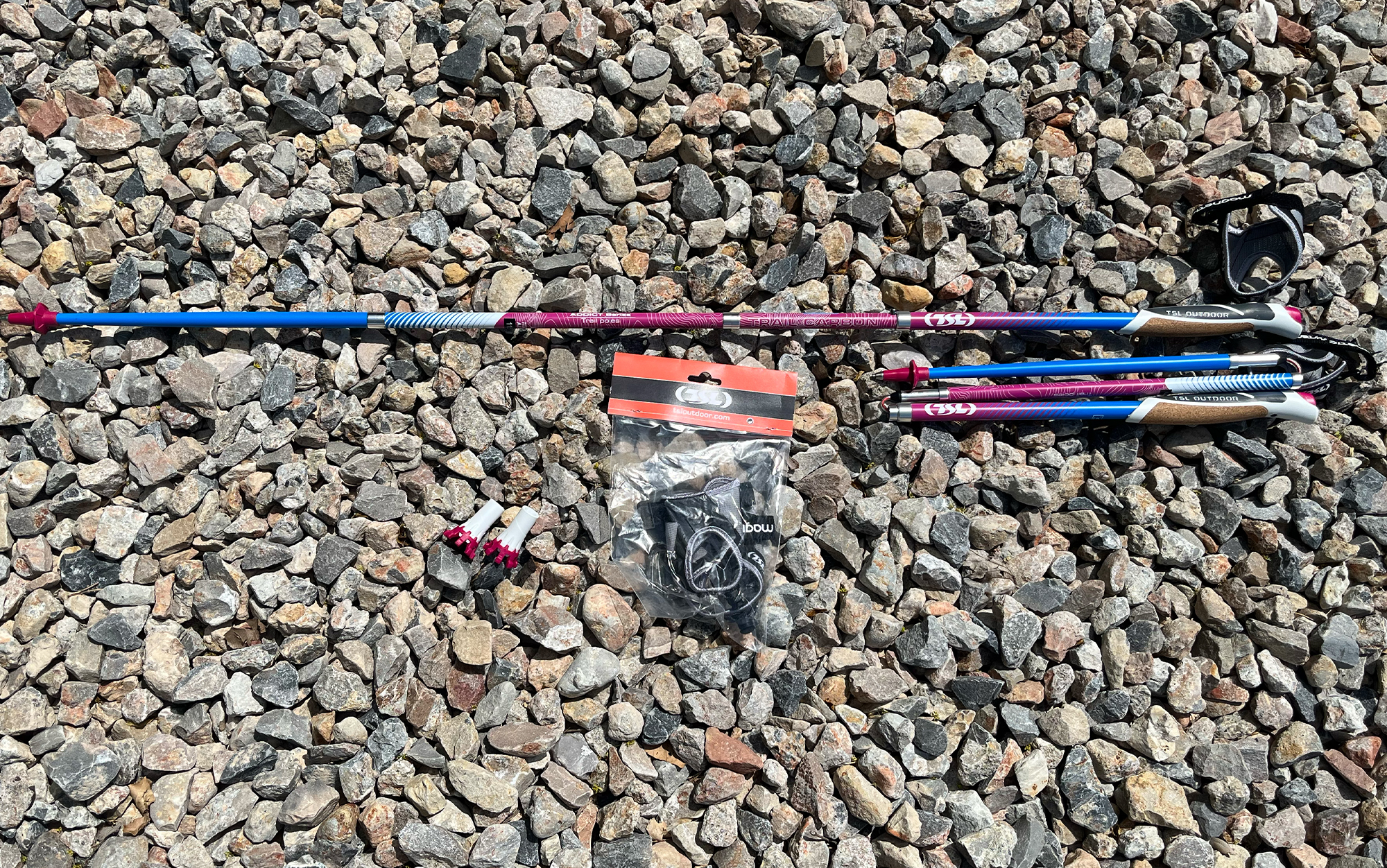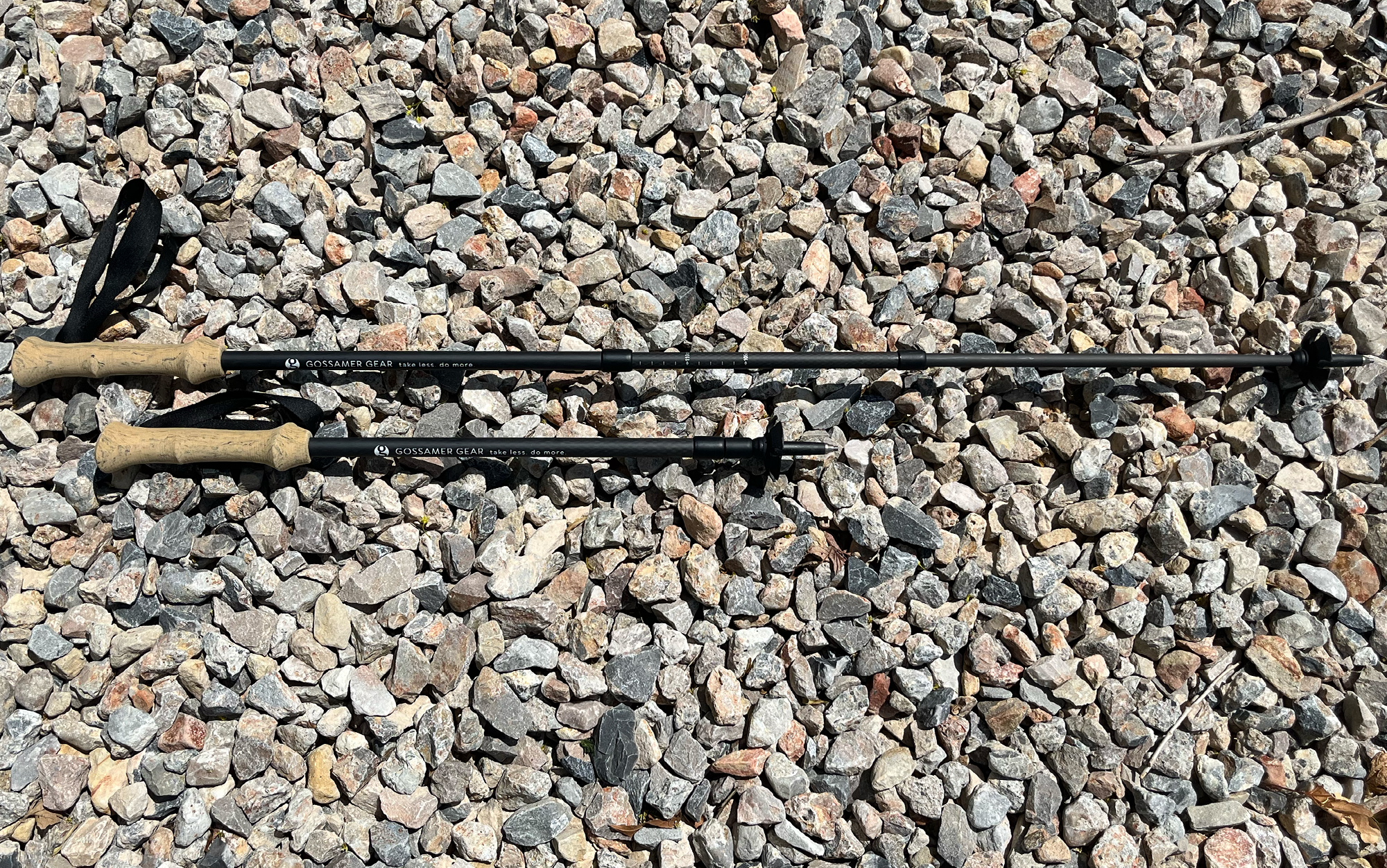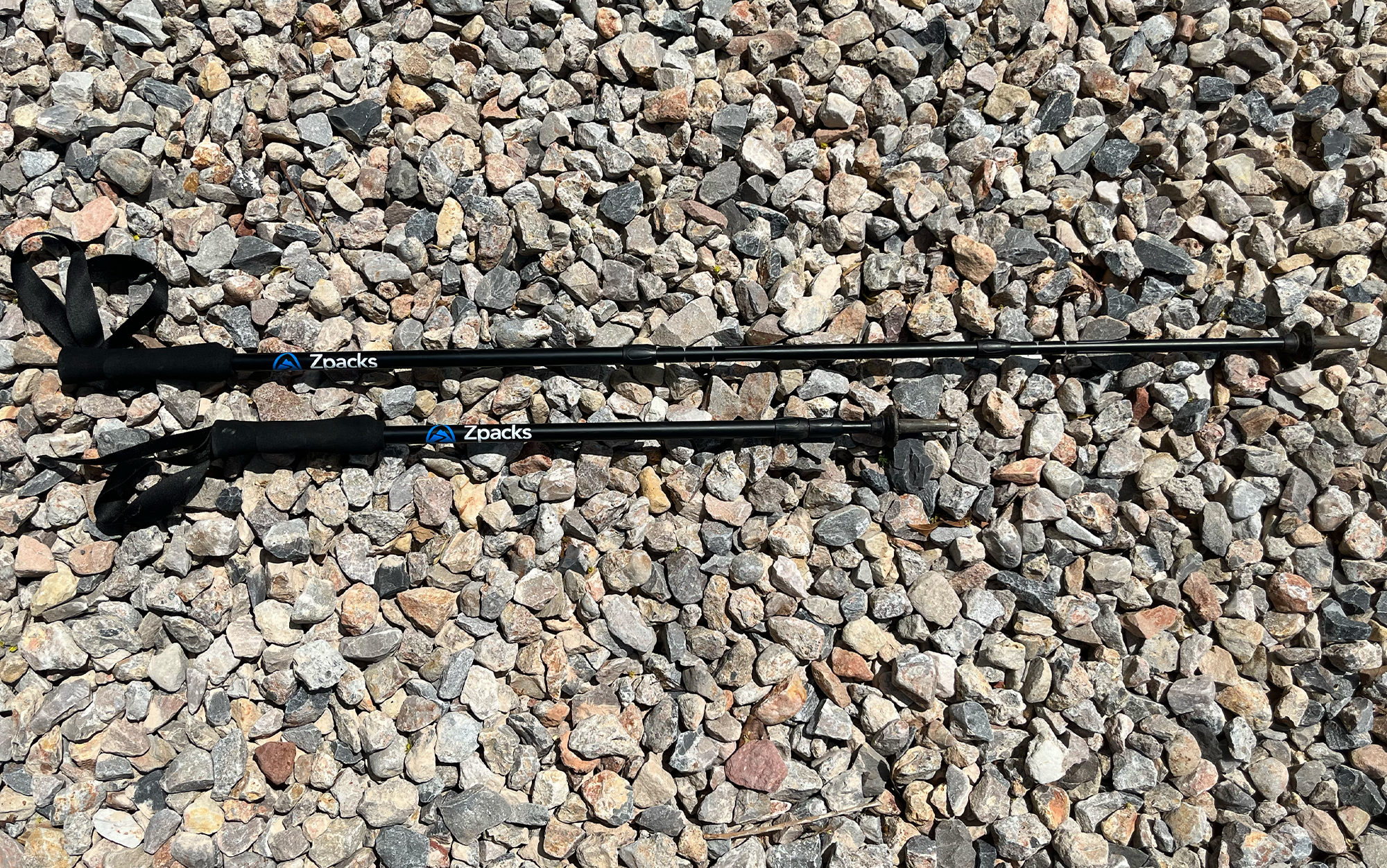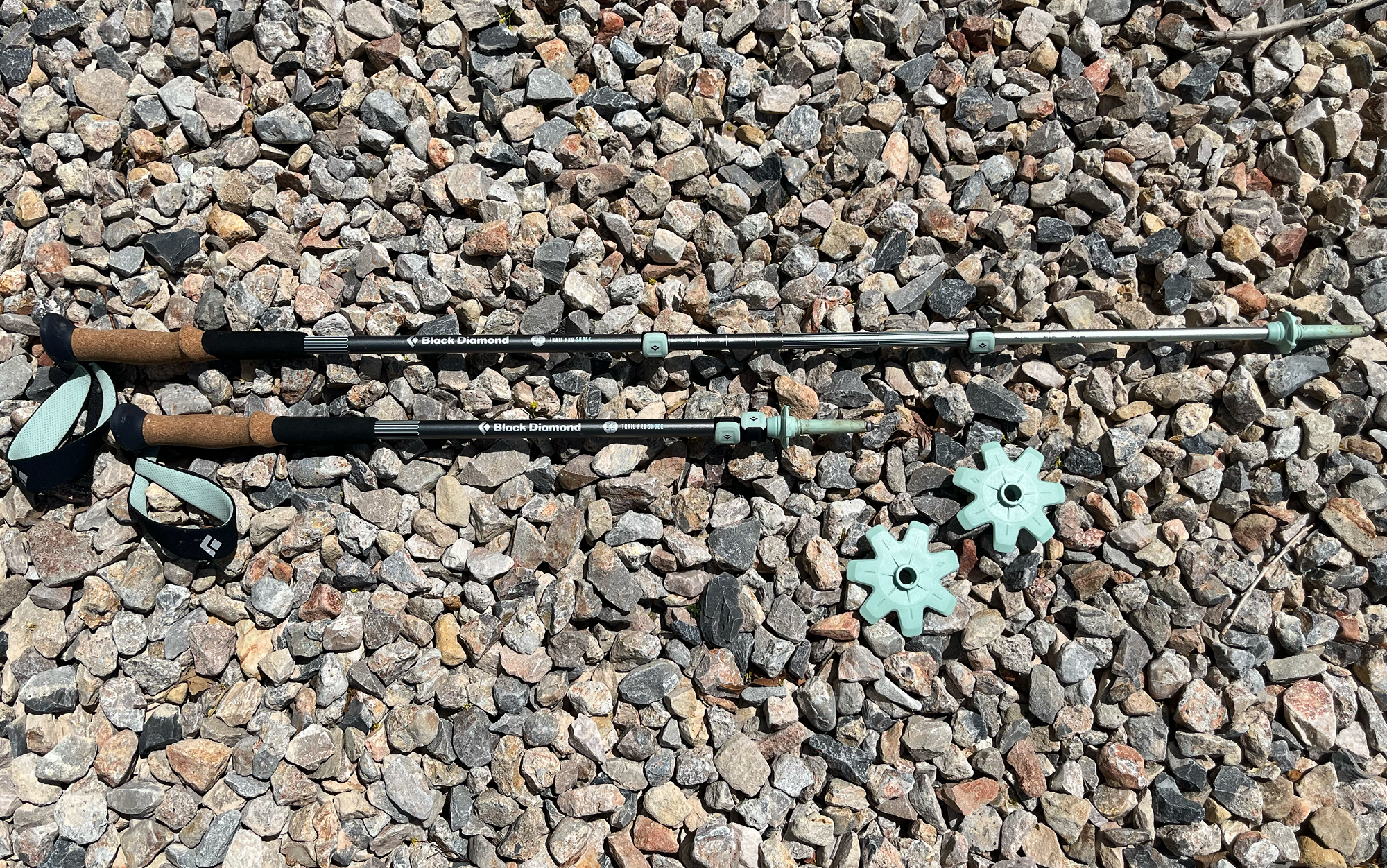We may earn revenue from the products available on this page and participate in affiliate programs. Learn More ›
Updated May 15, 2023 4:13 PM
Trekking poles distribute your weight to give you more stability on sliding scree, teetering talus, and roaring rivers. If your knees hurt while hiking or backpacking, trekking poles can help relieve that pain. Concerned about rolling an ankle? Trekking poles can add stability. If you struggle to keep up with your hiking partners, trekking poles can help get you into a speedy flow state.
When you factor in pack weight along with body weight, the extra stability and weight distribution can make you a more efficient hiker as well as alleviate stress on your body. Poles also keep your hands elevated to reduce swelling and are required to pitch some ultralight shelters. They can even be used as a support if injured. The poles on this list are collapsible and lightweight for stowing in your pack, storing, or traveling. We tested models from the top brands in a rigorous four-day backpacking gear test along the Oregon coast to determine which are the best trekking poles for various hiking conditions.
How We Tested the Best Trekking Poles
Five experienced hikers completed a portion of the 362-mile Oregon Coast Trail with the trekking poles on this list and other ultralight backpacking gear for Outdoor Life’s inaugural backpacking gear test. Our experience with trekking poles ranged from no experience, to sometimes using them, to bringing them on every backpacking trip.

During the backpacking gear test we used poles to summit and descend sand dunes, propel us forward over flat packed sand beaches, climb 1,200 feet of mud and dirt to camp, and navigate a semi-destroyed section of trail. This allowed us to test the stability, grip, and traction of each pair. Having multiple testers means we had multiple opinions and hiking styles to push each pole’s limits. The varying terrain also gave us a good idea of how these poles perform in different places. We also used them to pitch some of the best ultralight tents at the end of the day and rely on them to keep us sheltered through the night. Finally, I independently measured and weighed each pair to ensure the advertised specs were correct.
Best Trekking Poles: Reviews & Recommendations
Best Overall: Leki Makalu FX Carbon
Key Features
- Carbon fiber
- Grip: Foam
- Collapsed Length: 15.7 inches (40 centimeters)
- Max Extension: 51 inches (130 centimeters)
- Weight: 1 pound, 2 ounces
- Price: $239.95
Pros
- Most sturdy
- Locking wrist strap
- Extended grip
Cons
- Expensive
- Show signs of wear
- Confusing for some testers to disassemble and reassemble
These are the poles I want with me for a half mile, 1,000 foot descent through a scree filled couloir. The Leki Makalu FX Carbon are the overall best trekking poles for multiple reasons. They are among the top three heaviest poles in the test. However, the weight is perfectly balanced to use as forward momentum with every swing, giving my arms a break when I’m in a hiking flow state. The lightweight carbon fiber pole and hollow handle on top still make the pole feel relatively lightweight. And the carbide flex tips had stellar purchase in the soft ground of the Oregon coast.
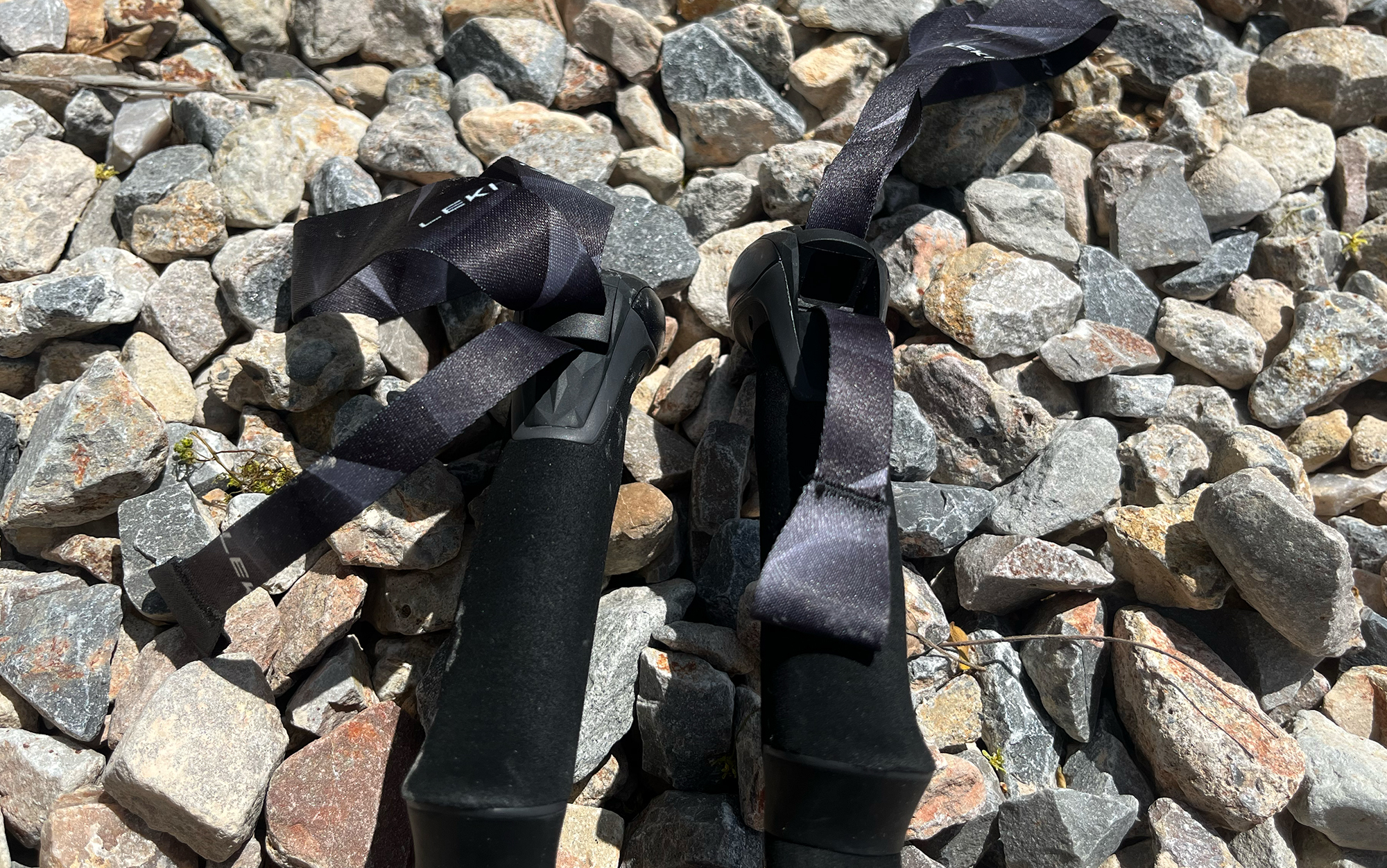
The ergonomic grip is 11 inches long for plenty of room to adjust your grip for the steepness of the terrain; grab lower on the pole for steep climbs where the ground is closer to you than normal, and rest your hands on the tops for steep down climbs where the ground is further away. The feel of the grip is also my favorite in the test. The light foam layer feels soft, but not plush because the grip is firm. I also appreciate that you can lock the wrist strap to a certain length. To unlock it, you must flip up a plastic hood on the handle. This secure locking mechanism means the fit won’t change when you press down with your arm or catch the strap on a snag.
The Leki poles did get a lot of sand stuck inside the upper shaft, causing a lot of small scratches and abrasions on the two upper portions. While this is purely aesthetic, with such an expensive set of trekking poles, you’d think they’d have a tougher paint job. Other poles did not retain as much sand or show signs of extreme wear from it. This sand could cause resistance when extending your poles later, so use this as a warning sign to wipe down your poles before storing.
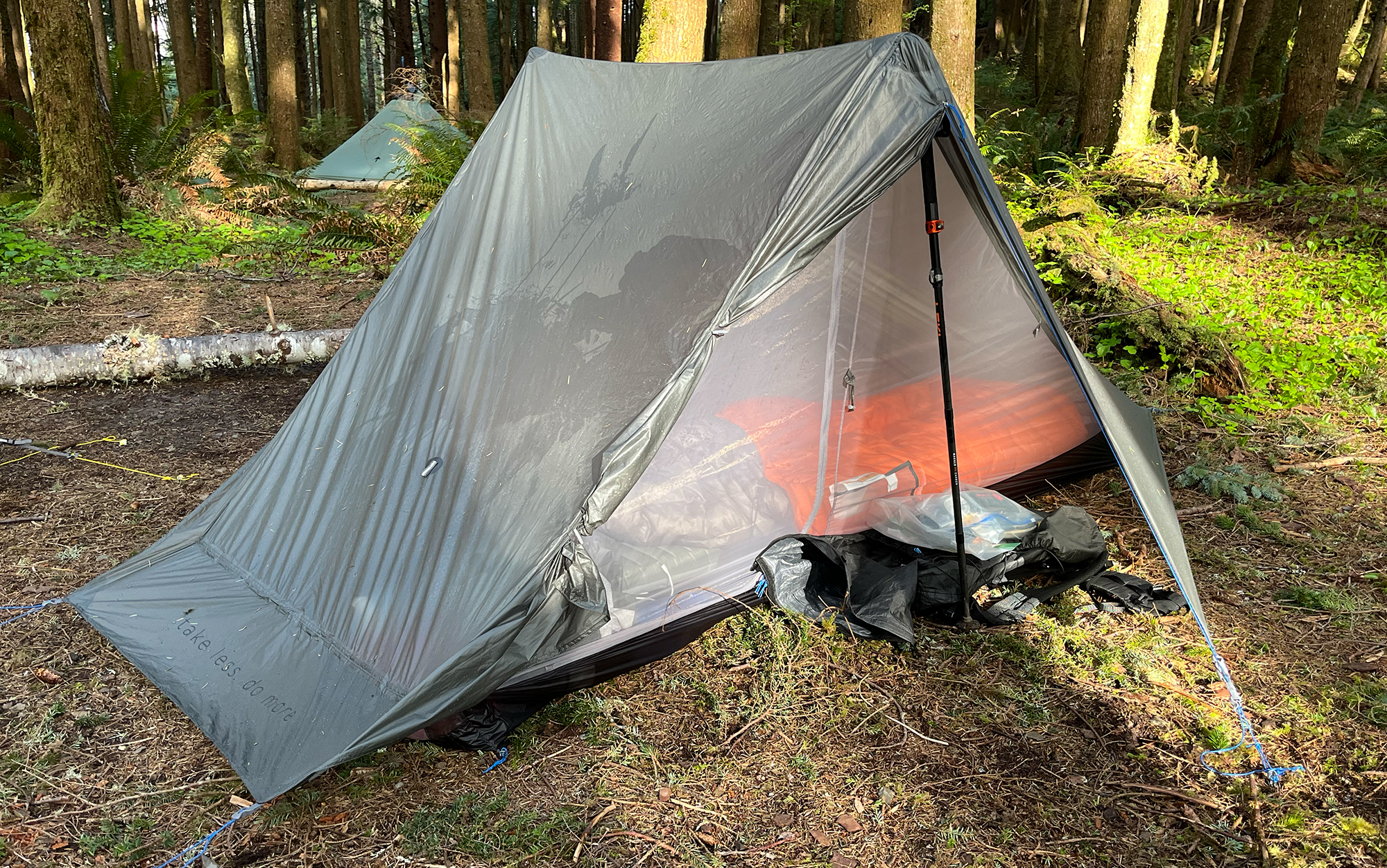
Some testers needed a tutorial by our resident Leki-head, Jac Mitchell, to put these poles together for the first time. You have to connect the bottom three pieces, but they won’t lock in place until you fully extend it with a considerable tug to lock the lower portion. Then you can adjust the upper shaft to your desired height. When constructing the best ultralight tent, the Makalua FX pole tips dug into the damp dirt easily and securely. The measurement ticks include both centimeters and inches, which can also come in handy if your ultralight shelter instructions only give one measurement.
Runner Up: TSL Connect Carbon 5 Cross
Key Features
- Carbon fiber
- Grip: EVA foam
- Collapsed Length (Measured): 17 inches (44 centimeters)
- Max Extension: 51 inches (130 centimeters)
- Weight: 1 pound, 1 ounce
- Price: $180
Pros
- External lock system
- Longest grip
- Include snow and trekking baskets as well as a new crossover tip
Cons
- Awkward wrist strap
- Confusing for some testers to disassemble and reassemble
The TSL Connect Carbon 5 Cross has a 14-inch grip giving you plenty of places to grab your pole while sidehilling, ascending, and descending. The external locks, flick lock, and Z pole design is the same as the Leki’s, providing more stability than twist-lock and dual flip-lock models. Tungsten tips ending in an asterisk shape provide great traction. These poles feel sturdy and reliable and were second only to the Lekis in our test of the best trekking poles. They’re also suited for winter missions because of their long grip, stability, and included snow baskets. A brand-new tip could make them perform optimally on ice, too.
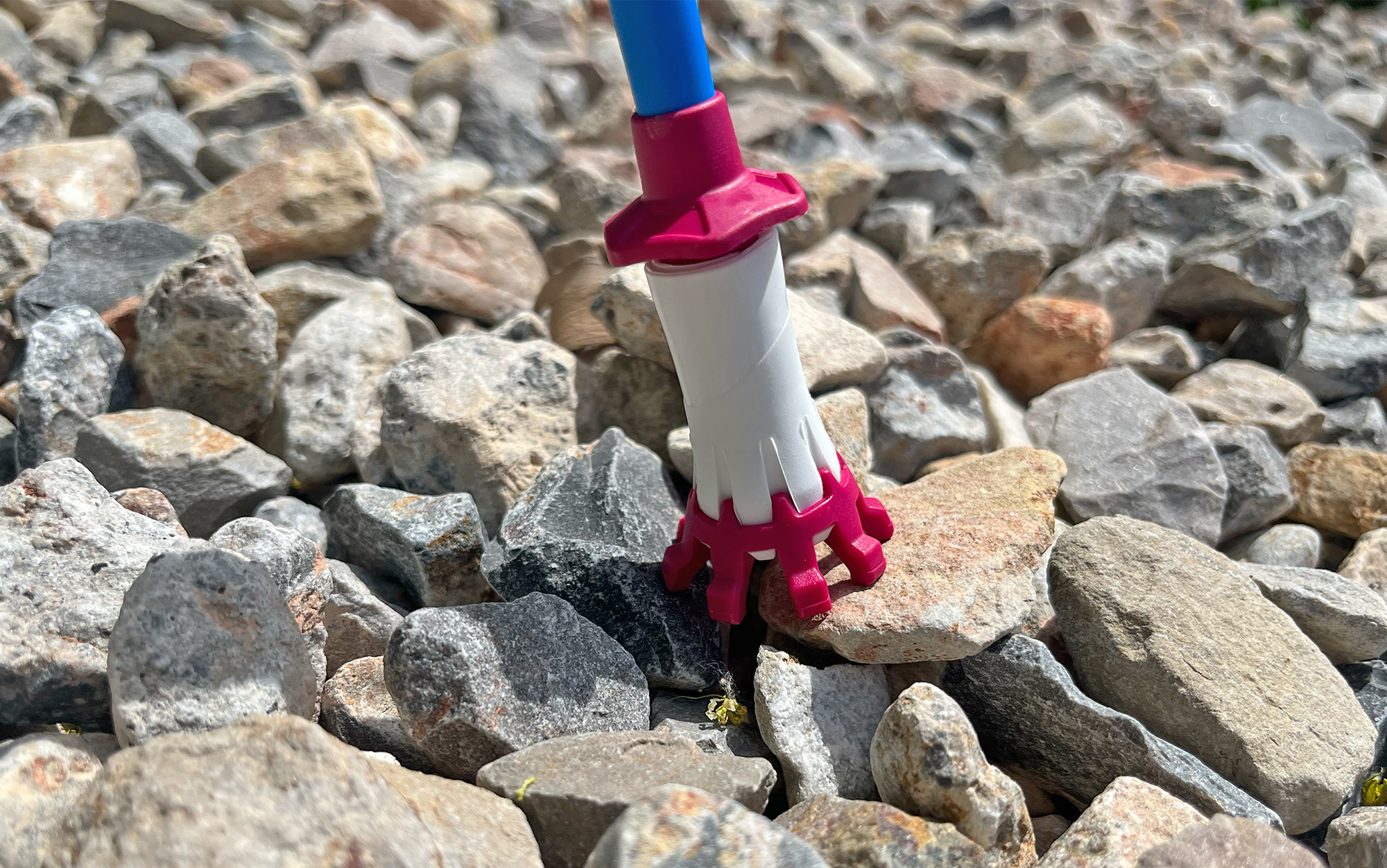
TSL poles now come with a crossover tip. It has eight feet designed to flex and grip with whatever terrain it encounters. They settle on top of gravel and loose rock well and would be great on ice. However, they do slightly increase the length of your pole so I made a micro adjustment to shorten mine when using the crossover tip. It also makes hiking with poles significantly quieter—a benefit for backcountry hunters wanting extra support while staying silent. I enjoyed testing this new tip, but there are some unique features that I was excited to try, that didn’t quite pan out.
The wrist strap locks into the handle via a magnetic attachment that is operated by a large protruding button at the top. If you want to take the wrist strap off entirely, you can press the button on top of the handle to detach it. I think this system works better with the glove attachment rather than the strap attachment (more on the glove later). The strap is long with a large buckle and the excess strap feeds through to form two loops. The loops are clunky and the magnet attachment point is inconveniently placed exactly where I want to put my hand, but you can get used to it.
Testers ended up using the button more as a fidget toy while hiking. Some testers were also concerned that the button sticks out of the handle instead of being semi-protected depressed into the handle. Since it sticks out, it could be hit accidentally by yourself, a rock, a tree, etc. and then you’ll lose a pole. We were also concerned about the longevity of so many moving parts.
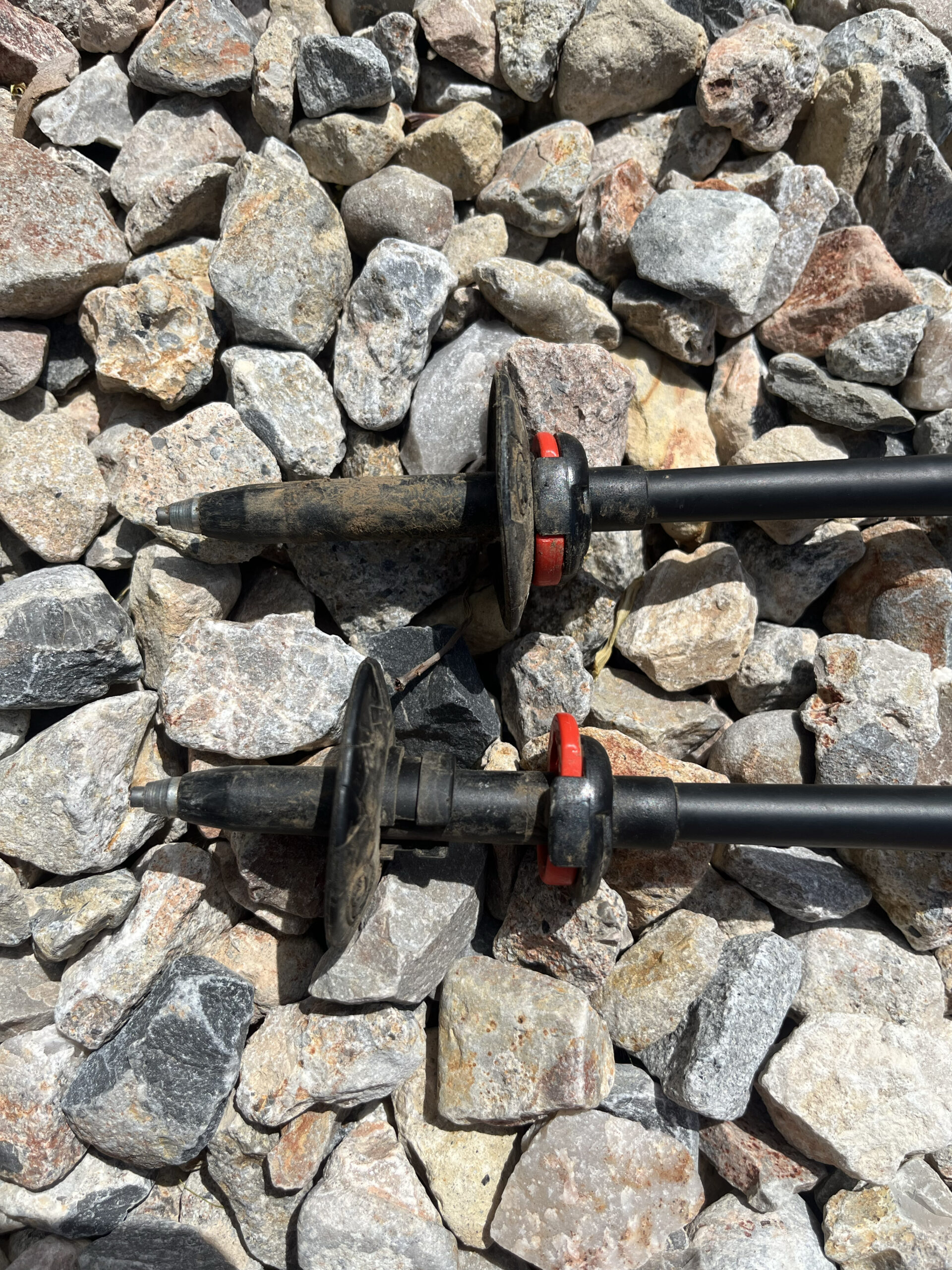
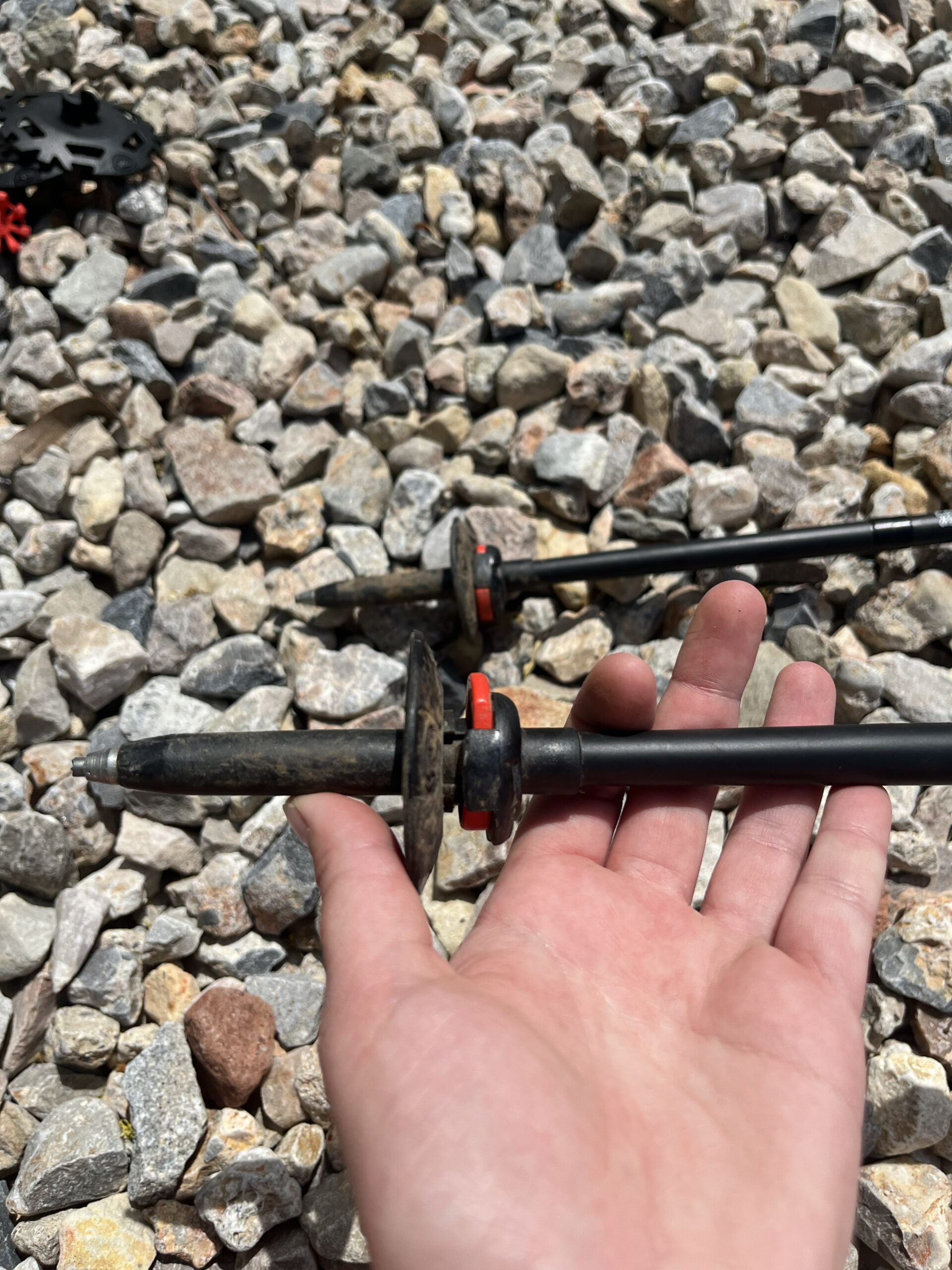
Another unique feature is the patented push and pull basket system. You push a button and pull down on the basket to remove it. I would opt for the traditional twist method, which is still available when selecting your poles. The button became clogged with mud from testing and made it difficult to remove the basket afterwards.
Most Versatile: MSR Dynalock Explore Backcountry Poles
Key Features
- Aluminum
- Grip: EVA foam
- Collapsed Length: 24.5 inches (62 centimeters)
- Max Extension: 55 inches (140 centimeters)
- Weight: 1 pound, 4 ounces
- Price: $109.95
Pros
- Powder and trekking baskets
- Tool-free tensioning
- Longest pole we tested
Cons
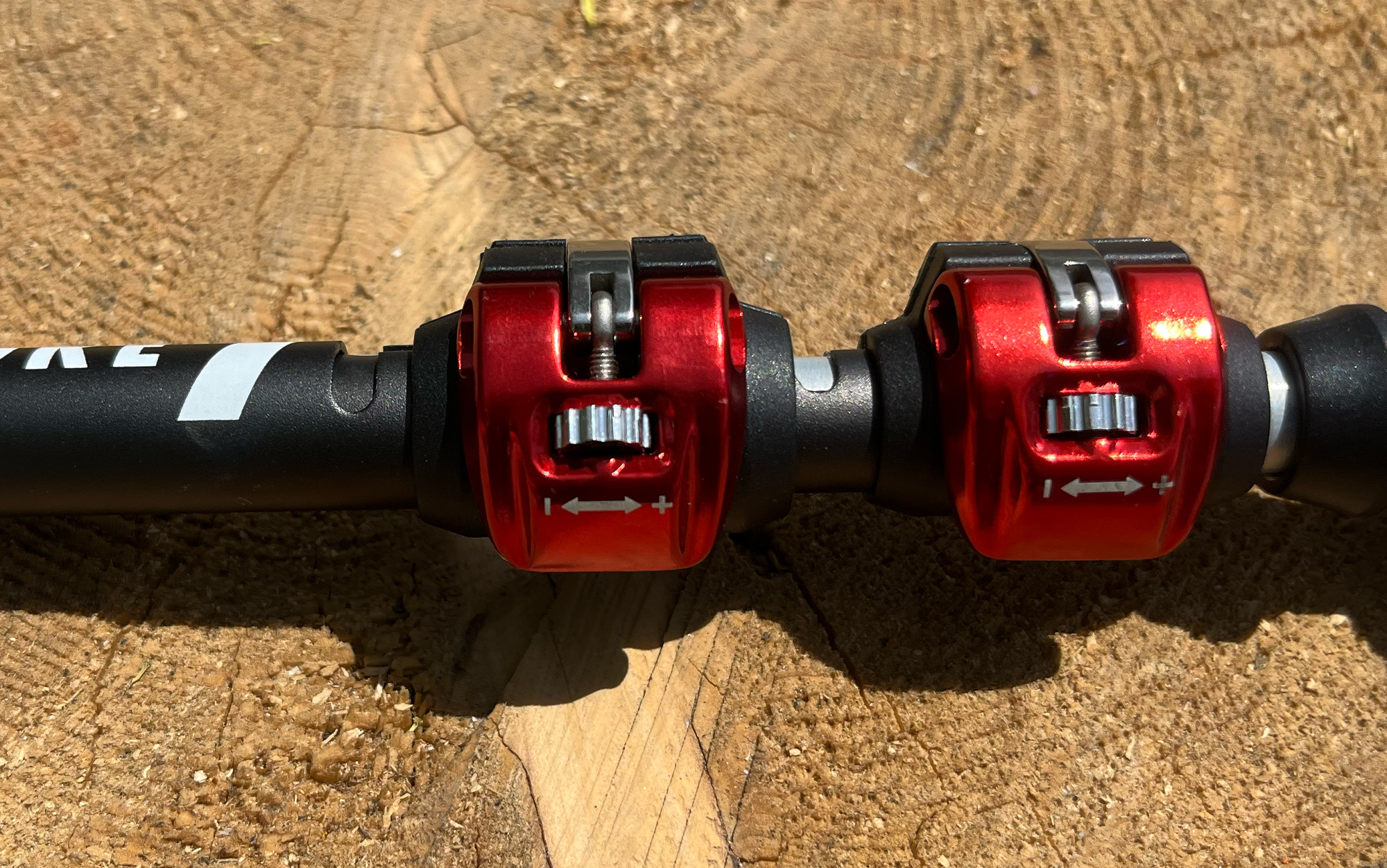
The MSR Dynalock Explore Backcountry Poles are the heaviest on our list but they are also the longest, extending up to 140 centimeters. Centimeters are the only measurement on the pole, no inches, which can be less confusing for new trekking pole users. The aluminum construction feels sturdy and the Dynalock switches prevented the poles from telescoping closed even with all my weight on them. The locks also feature tool-free tensioning so that you can tighten or loosen the snap closure with a simple adjustment wheel. This means if your poles take some abuse or start to loosen with motion and weight compounding on them; you don’t have to worry about the locks de-tensioning on your trip. You have the ability to keep them tight even in the backcountry.
The EVA foam grip extends 10.5 inches down the shaft so you have plenty of grip options for ascents, descents, and side hilling. The carbide steel tips can handle abuse on rock and ice with excellent traction. MSR includes snow baskets to keep your poles from sinking in deep snow and trekking baskets to keep poles from sliding into mud, sand, or crevices. The hearty construction, easy tension adjusting, and 10.5-inch grip make these the most versatile trekking poles for winter missions or three-season hiking. They stood up to the sea and sand of the Oregon coast while taking more abuse from rocks and mud in the forested sections, and they still look new.
Best Value: Cascade Mountain Tech Ultralight Carbon Fiber 2 Section Quick Lock Trekking Poles
Key Features
- Carbon fiber
- Grip: EVA foam
- Collapsed Length: 30 inches (76 centimeters)
- Max Extension: 52 inches (132 centimeters)
- Weight: 10.2 ounces
- Price: $42.99
Pros
- Good price
- Four different tip attachments
- Extended grip
Cons

I’ve tried budget trekking poles before; you know the $20 ones on Amazon, and they couldn’t handle my weight, telescoping shorter and shorter every time I actually relied on them. Don’t waste your time on no-name budget trekking poles. If you’re looking for a good value, start with these ultralight carbon fiber trekking poles from Cascade Mountain for $43. The first time one of our testers tried these, they did collapse under pressure, but all she had to do was open the lock, turn the tension knob, and re-lock the poles for reliable stability. There’s also only one flip-lock, so there’s less chance for failure.
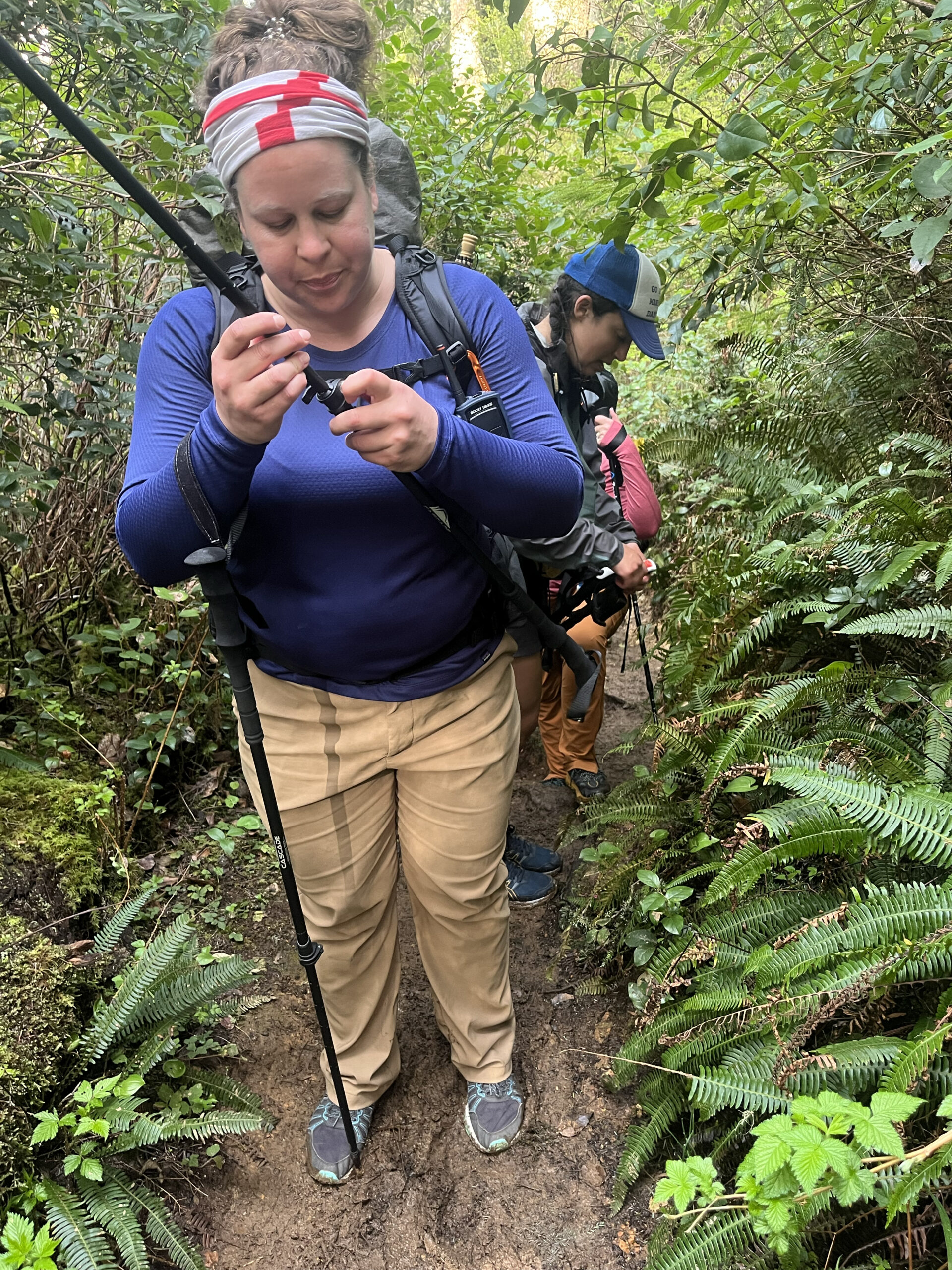

The tungsten carbide tips have an asterisk pattern on the bottom for increased traction. The four different tips are also designed for different terrain: snow baskets, trekking baskets, and rubber boots and rubber tips for walking indoors, on pavement, or protecting the tips while traveling or storing. Testers loved the light weight, 10.5-inch extended grip, and comfortable and adjustable wrist strap. These do have the longest collapsed length, so they don’t store as small as others on this list.
Best for Trail Running: TSL Addict Trail Carbon 4 Sky Cork
Key Features
- Carbon fiber
- Grip: Cork
- Collapsed Length: 15 inches (38 centimeters)
- Available Sizes: 105, 110, 115, 120, and 125 centimeters
- Weight: 14 ounces
- Price: $140
Pros
- One external locking mechanism
- Lightweight
Cons
These are the best trekking poles for trail running because it’s almost impossible for them to fail, they’re lightweight, and they have a detachable magnetic glove instead of a strap. They also come in fun colors; Jac Mitchell nicknamed them the Barbie poles during the backpacking gear test as this model is pink and blue. The Trail Carbon 4 are Z poles with one external locking mechanism in the form of a pin that protrudes once they’re extended fully. That makes these the most reliably stable poles in the test in my opinion. For them to collapse closed, the pin would need to be accidentally pressed or break entirely. They’re also lightweight while still feeling substantial and the traction is great.
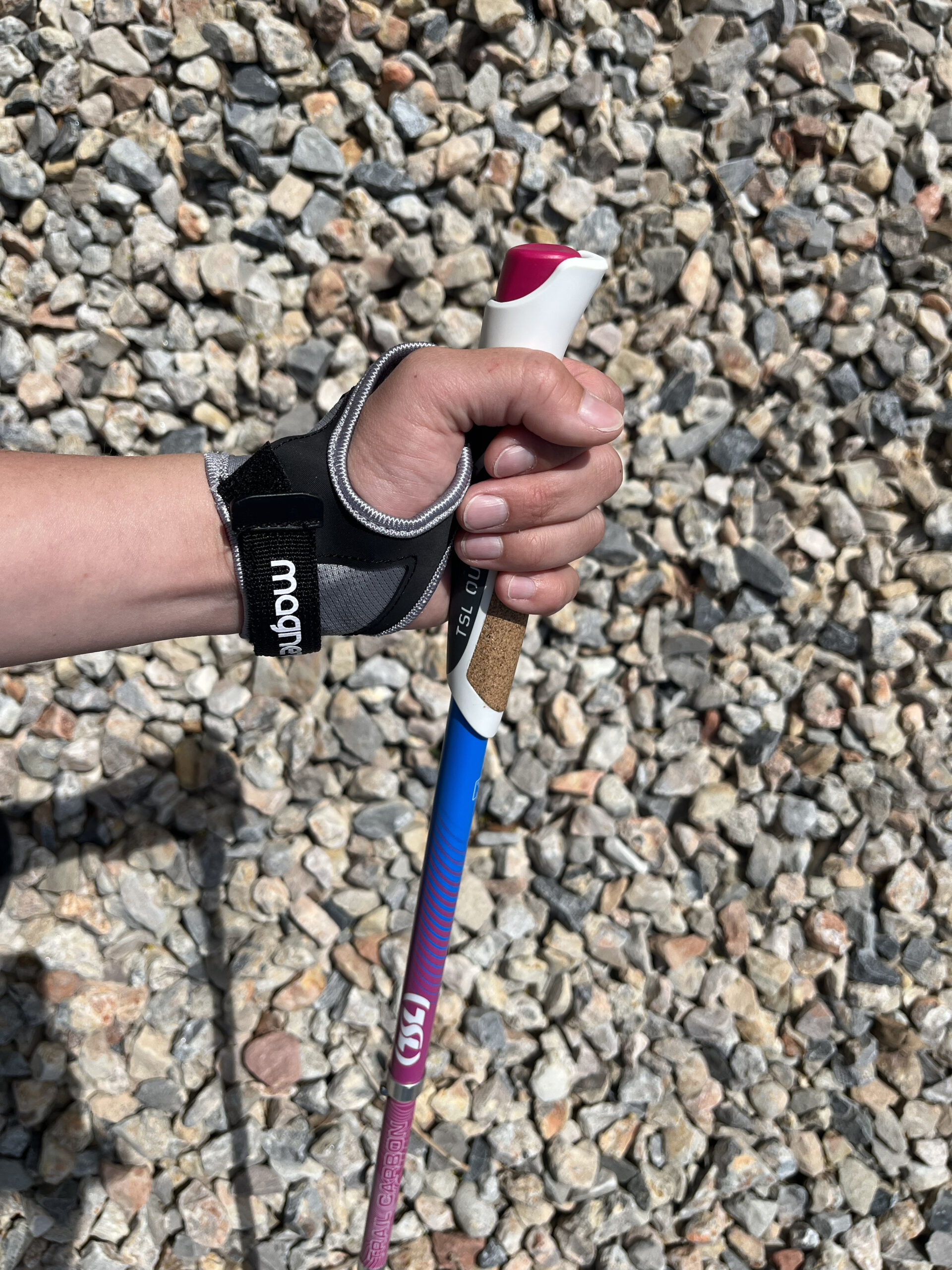
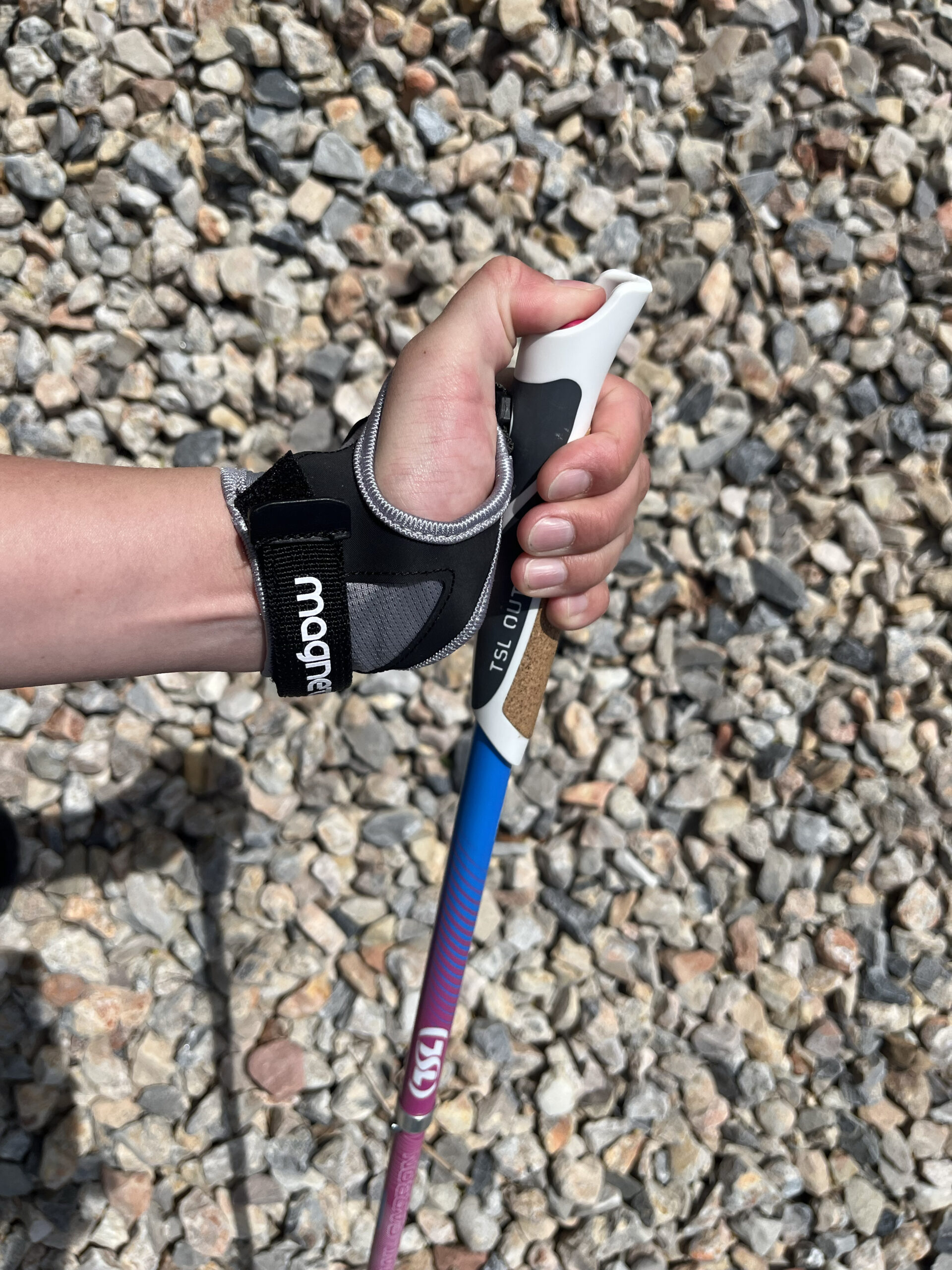
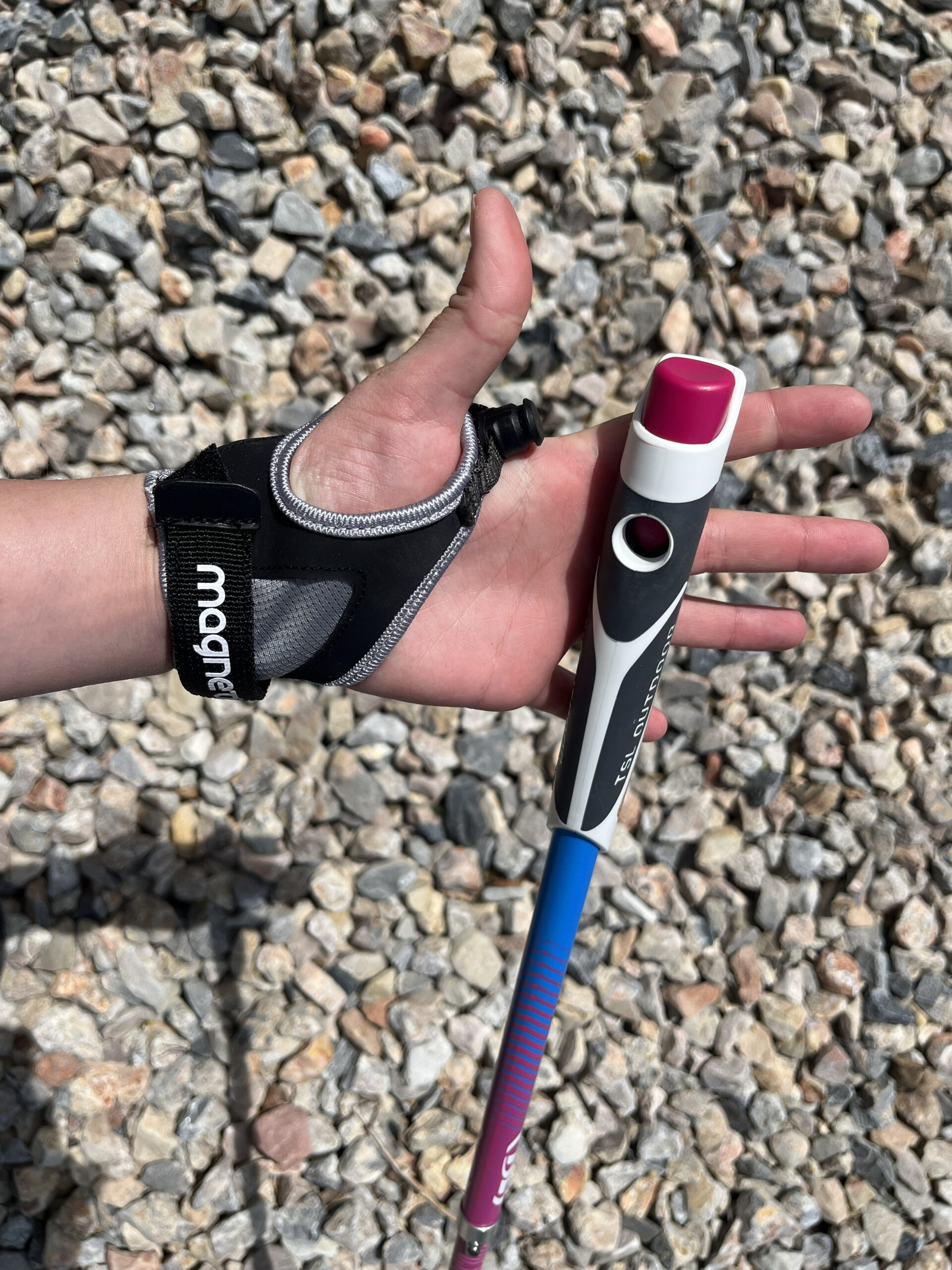
This is the model where I think the TSL magnetic glove system works, though I wouldn’t say it shines. The ergonomic glove means your hand is in the ideal position to strike the ground with your pole every time. When you want to put them away, you can easily unclip the glove and quickly stow your poles to keep moving. My only issue with the magnet on these poles, aside from the possibility of it accidentally being hit and losing a pole, is that I can’t easily operate it one handed. My thumbs are too short to depress the button while also moving my hand far enough from the grip to pop out of the attachment smoothly.
You can purchase the Trail Carbon 4 poles in 105, 110, 115 (our test model), 120, and 125 centimeters. But none of them are adjustable. That makes an extended grip more important because you can’t shorten the poles for uphill. This model has a standard grip, but be sure to select the cross model for optimal uphill use. That also means that if you choose to use the included crossover tip, you can’t make any micro adjustments for the slight length increase.
Best for Pitching a Trekking Pole Tent: Gossamer Gear LT5 Carbon Trekking Poles
Key Features
- Carbon fiber
- Grip: EVA foam
- Collapsed Length: 23.5 inches (60 centimeters)
- Max Extension: 51 inches (130 centimeters)
- Weight: 10 ounces
- Price: $195
Pros
- Lightweight
- Light grip color
Cons
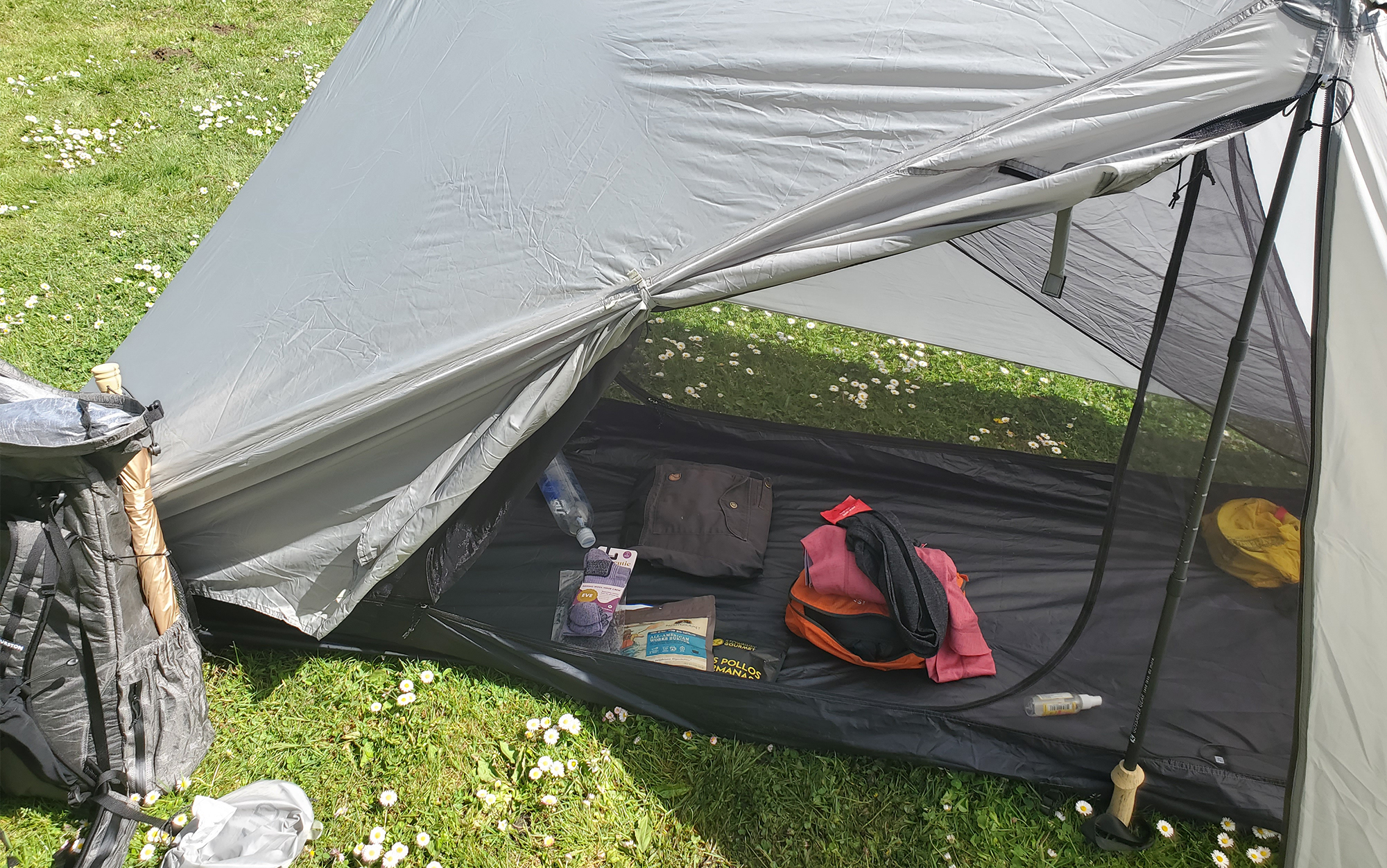
While lightweight, testers thought the Gossamer Gear LT5 poles were surprisingly sturdy. A downside of the low weight is that there isn’t much forward momentum with each swing so your arms feel like they’re the only active force keeping them moving. The carbide tips provide great traction and are replaceable if they show too much abuse. While the grip is not extended, it is sizable at 6.5 inches. Some black foam grips can turn your hands black after you sweat a lot, so I appreciate the light brown foam of the grip. The grip also has an index finger rest and is textured on the back for easier holding.
The LT5 trekking poles feature one set of centimeter measurements on the upper shaft. I like this better than measurements on both shafts to keep things simple. The lower shaft is simply extended until you can no longer see the “stop” signal, then adjusted to your preferred height on the upper. However, they are twist locking which is why they’re so lightweight. There are pros and cons of each locking mechanism that I’ll go over later, but twist locks require more effort to adjust and can trap debris. Though, these poles come completely apart so you can clean and dry each portion after your trip. Gossamer Gear’s LT5s are especially nice if you plan to use them for one of the best ultralight tents because they’re sturdy, lightweight, and extend to 132 centimeters.
Best Minimalist: Zpacks Minimalist Trekking Pole
Key Features
- Carbon fiber
- Grip: Foam
- Collapsed Length: 24 inches (61.5 centimeters)
- Max Extension: 52 inches (132 centimeters)
- Weight: 10.2 ounces
- Price: $59.95
Pros
Cons
The Zpacks trekking poles have tiny trekking baskets and the shortest grips (5.5 inches) of any in our test. The wrist strap is simple and adjustable and the poles use twist locks. The Zpacks Minimalist are, as the name suggests, very basic. This is evidently what makes them extremely lightweight. They collapsed under my weight once, but after re-tightening, they were fine. However, they have more give than the 0.2 ounces lighter Gossamer Gear LT5 poles.
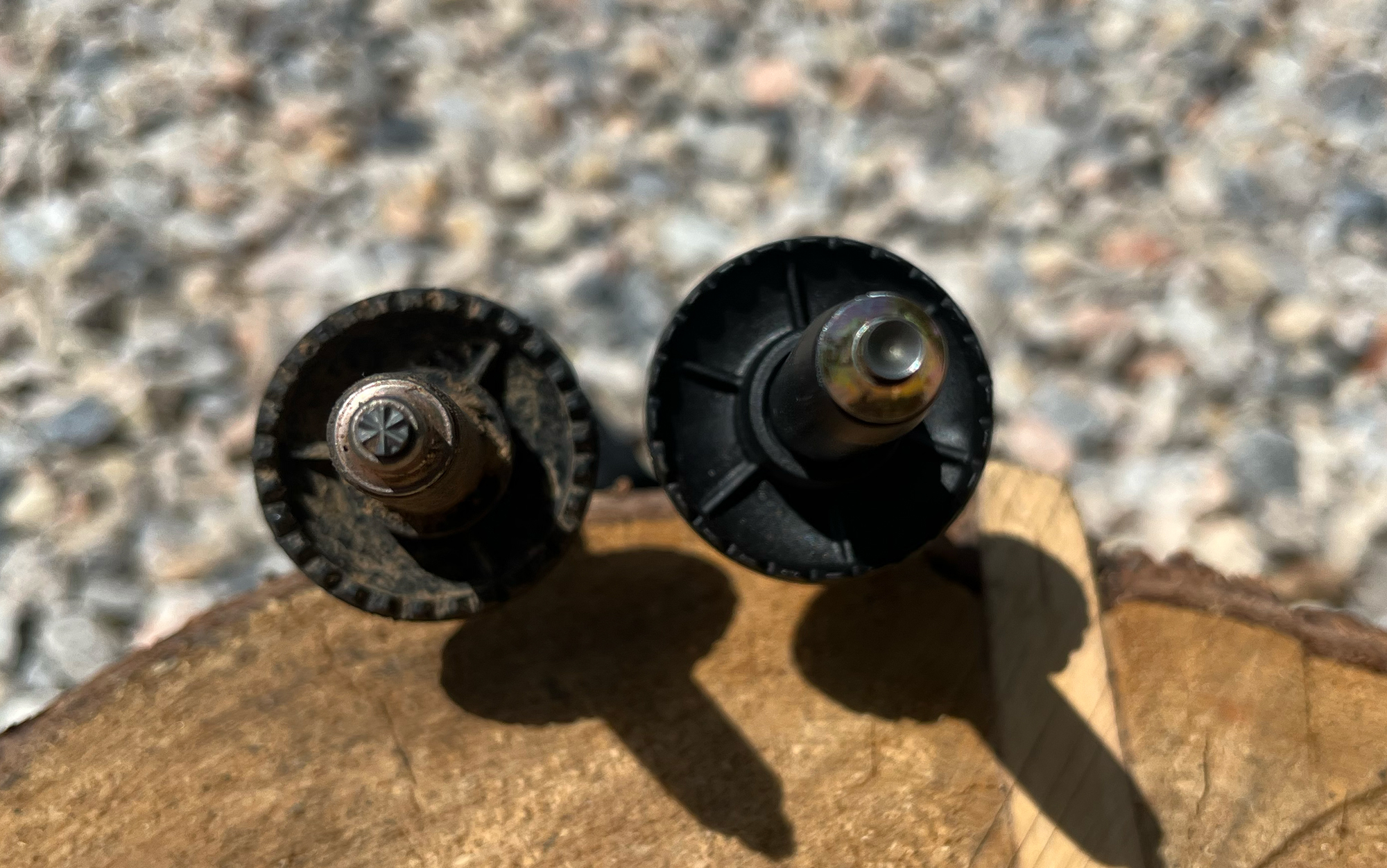
The Minimalist Trekking Poles are almost as lightweight as the LT5s with slightly less grip length and more of a springy feel, but are a third of the price. So if you’re counting ounces on a budget, these are a great option. There are centimeter markings on both shafts to attain your preferred length, which I find overly complicated, but not a deal breaker. The metal tips feature an asterisk pattern for increased traction.
Best for Day Hikes: Black Diamond Pursuit Shock
Key Features
- Aluminum
- Grip: Cork
- Collapsed Length: S/M 26.5 inches, M/L 28.4 inches
- Available Sizes: S/M 125 centimeters, M/L 140 centimeters
- Weight: S/M 1 pound, 3 ounces; M/L 1 pound, 6 ounces
- Price: $189.95
Pros
- Comfortable wrist strap
- Cork grip with Bloom extension
- Shock absorbing handle
- Includes snow baskets
Cons
- Must use integrated tool to adjust lock tension
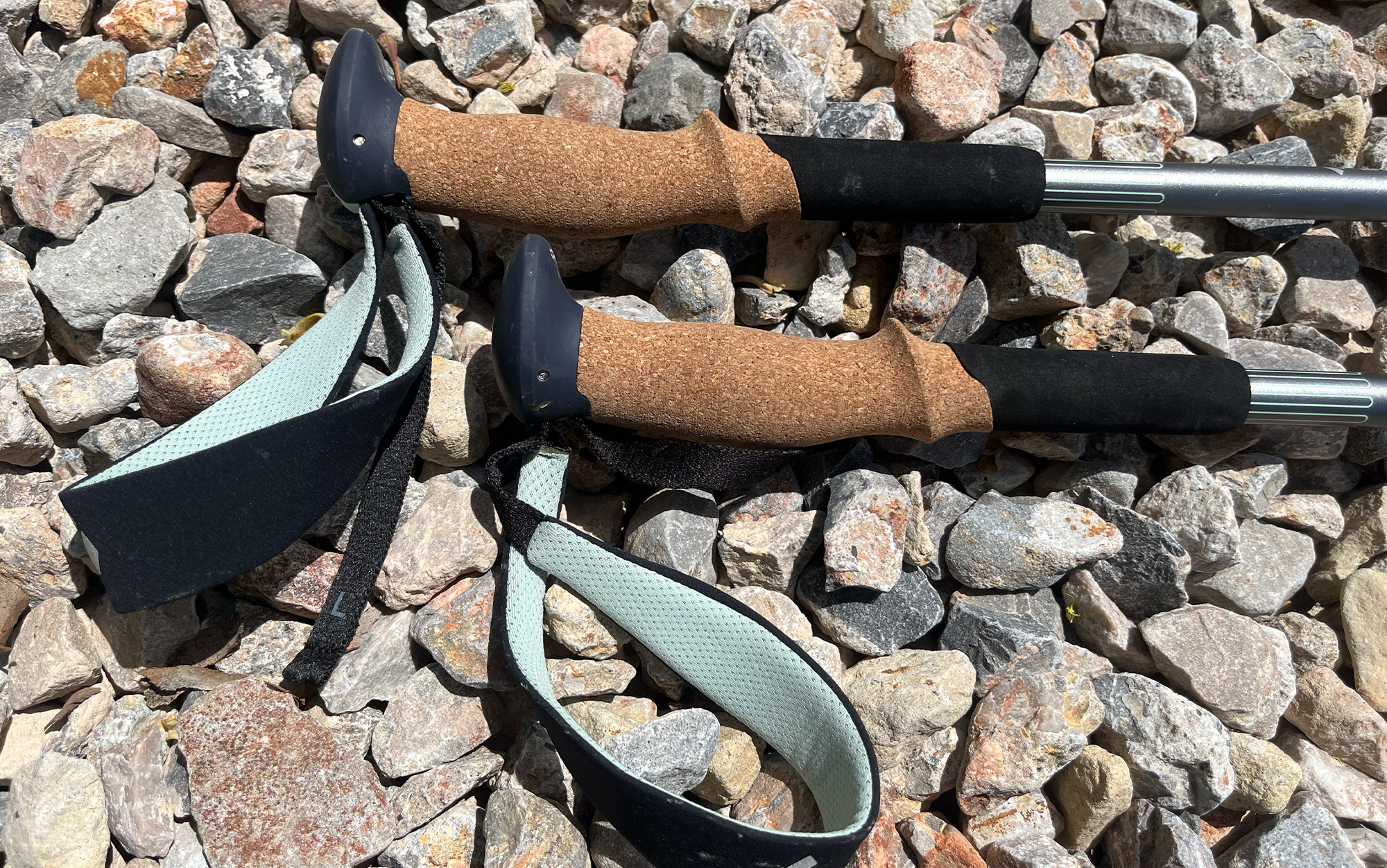
The grip of the pole actually depresses slightly as you ascend and descend for more efficient shock absorption and a springy feel. I felt the streamlined shock technology in the Pursuit’s handle lived up to its name by reducing vibrations in the poles while hiking. The slight movement of the grip worked with my gait allowing me to feel less stress on my joints when taking a big step up or down.
Testers also liked the cork grips because it didn’t leave any residue on their hands and worked well even when their hands started to sweat. Cork feels slightly abrasive to me, but if you know you love cork, you’ll love these ergonomic grips. The wrist straps are even marked with an L and R so your hand comfortably rests in a shape specifically designed for a left and right grip which feels relaxed and natural, designed to reduce hand fatigue. The grip extension is made from Bloom, an algae-infused foam, in an effort to use more sustainable materials. Black Diamond’s wrist strap is also plush and breathable.
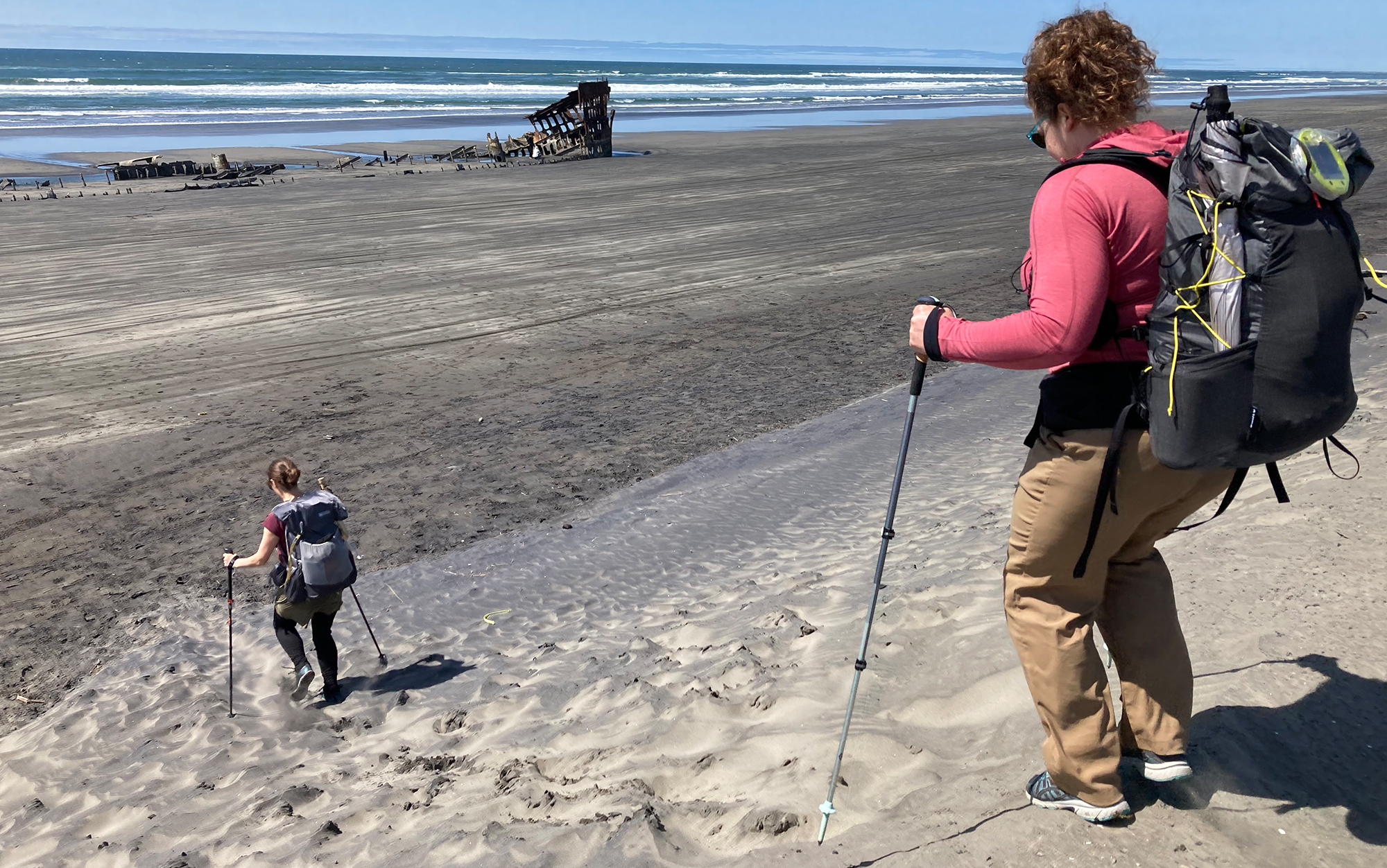
The Black Diamond Pursuit Shocks are great for day hikes because they’re comfortable and made of sturdy aluminum; however, they aren’t our top pick for backpacking because the S/M size is slightly too short for some of the best ultralight tents. There are two flip locks to fully extend the poles, each with centimeter measurements. Again, the dual measurements can be annoying when you’re starving and setting up a trekking pole tent in the dark, but aren’t a real issue. These poles come in two sizes: 100 to 125 centimeters and 125 to 140 centimeters. Learn more about what length pole is right for you below, but if you’re under 6 feet tall, you’ll most likely opt for the S/M size poles. Be aware that some ultralight tents recommend extending your poles to 132 centimeters, so read your trekking pole tent’s instructions before committing to shorter poles.
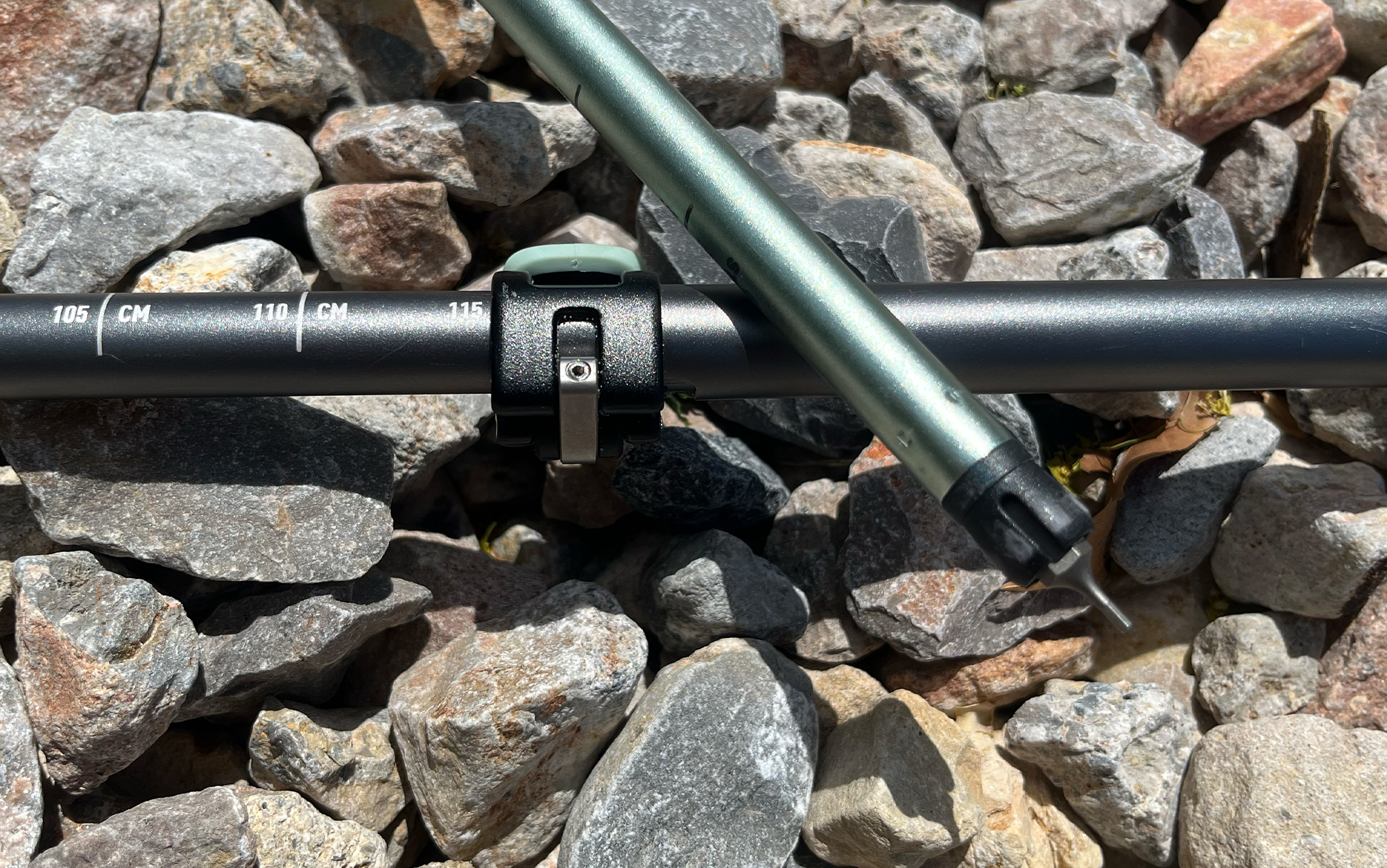
While other trekking poles in this test offer tool-free tensioning via a wheel or knob, the Black Diamond poles include a hex tool encased inside the right trekking pole. You have to use the stored tool inside the right shaft to adjust the flip lock tension. Hopefully, on a day hike, you won’t have to bother with this. But on a long backpacking trip or thru-hike, using your poles all day for a week at a time, stopping to dig out a tool and fiddle with your poles sounds inevitable, and annoying.
Things to Consider Before Buying the Best Trekking Poles
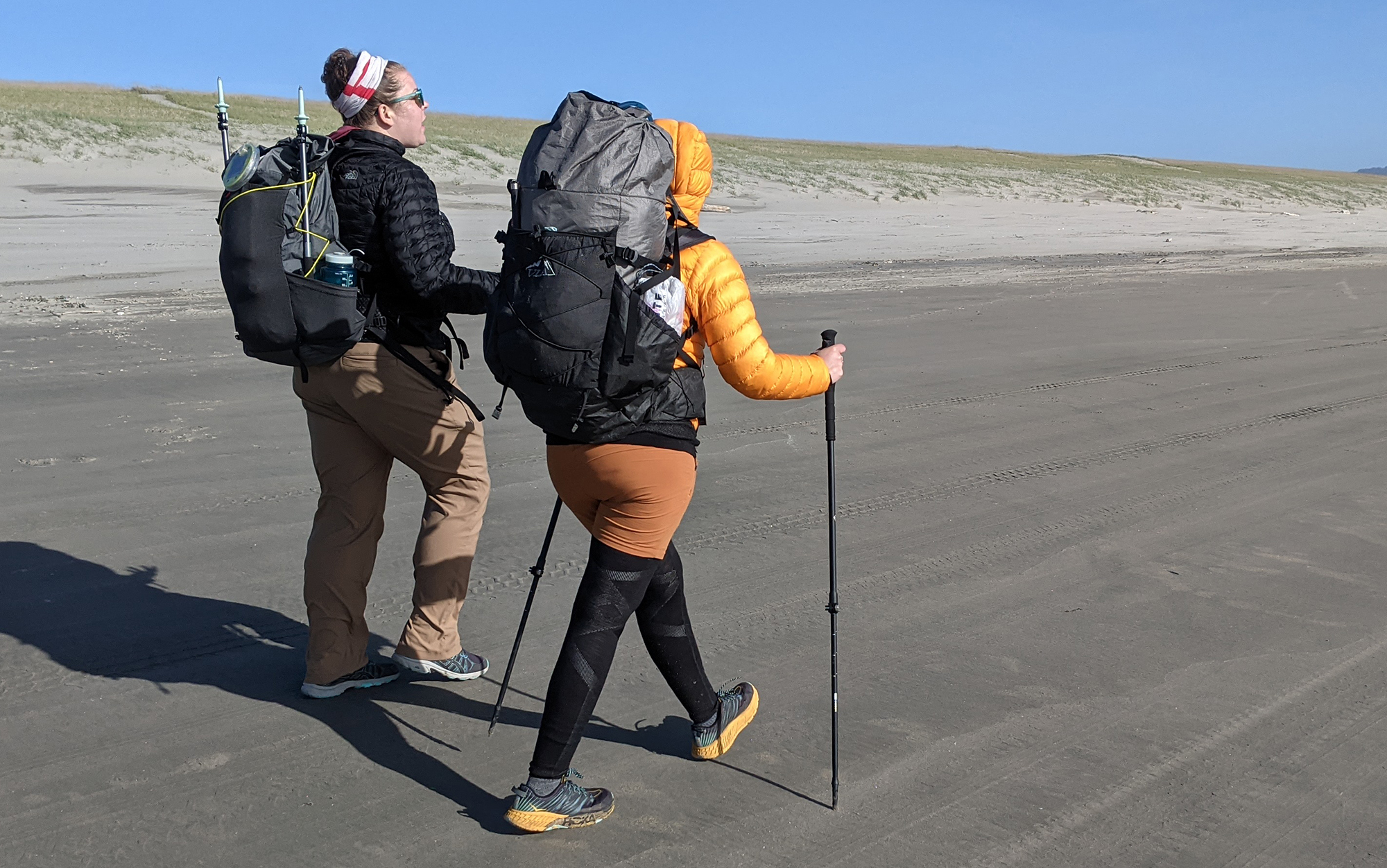
I tend to refer to poles as “cheating,” to the chagrin of some hiking buddies. On tough climbs they feel more efficient, easier, and faster. A mini-study in Jackson, Wyoming, noted that trekking poles decreased the rate of perceived exertion by 20 percent on a steep grade with a heavy pack. While the study was small, I agree with their conclusion.
However, most people invest in the best trekking poles for the downhill, not the uphill. If you’re experiencing knee or lower back pain on steep descents, trekking poles can help save your joints. While the main utility of trekking poles is to reduce wear and tear on your joints, I think they have more to offer. The best trekking poles can also help you achieve a flow state while hiking. Use their momentum to get in the zone, increasing your speed to keep up with your hiking partners.
Here I’m going to break down the deciding factors of the poles in this test so that you can choose the best trekking poles with features that are right for your hiking style.
Length
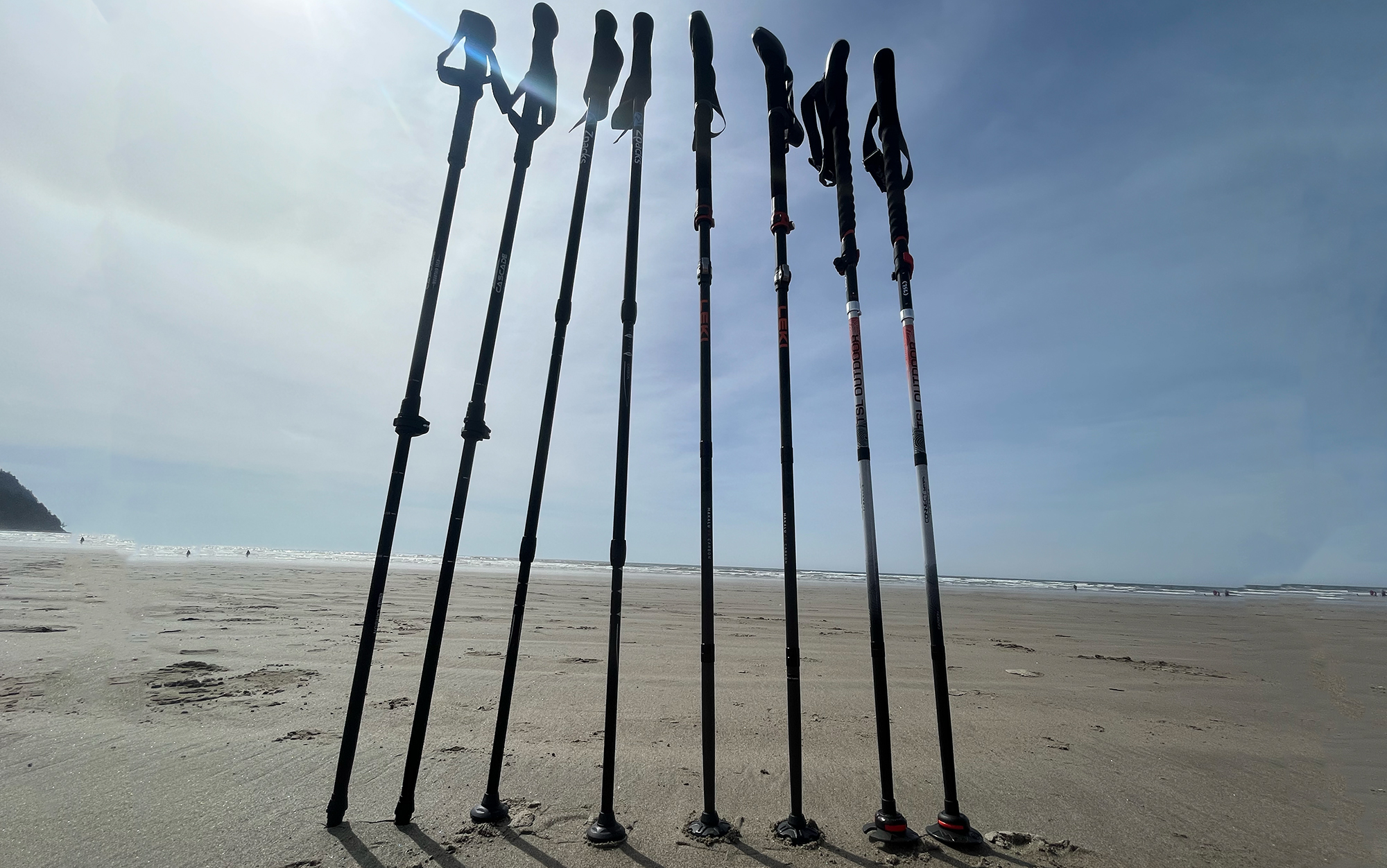
Trekking poles are typically adjustable and come in multiple size ranges. One way to loosely determine your range is to put your foot on a tape measure and put your hand under the dispenser as if you’re holding a pair of poles. Then raise it until your arms are at a 90 degree angle at the elbow. Lock it and check the height; most are sold in centimeter ranges. Once you have a general size range, repeat this process with an actual pole to find the exact length. Keep your arms close to your sides and hold each trekking pole with the tips close to your feet. Your arms will form a 90 degree angle at the elbow when the height is right.
From there you can make micro adjustments to whatever terrain you encounter; lower them for steep inclines and raise them for steep declines. The benefit of the best trekking poles with extended grips is that you can hold one pole lower than the other while moving across a hill laterally. When pitching a trekking pole shelter, your specific tent will tell you what height to set your poles, but the max height in the best ultralight tents test was 132 centimeters. Keep this in mind if you plan to pair your poles with a shelter.
Locking Mechanism

There are three main mechanisms for locking trekking poles, external buttons (like those on the legs of an adjustable folding table), external flip locks, and twist locks. The buttons are the most reliable because it acts as a physical barrier. It would have to be accidentally pressed or completely break to fail.
As your poles absorb shock while hiking, they vibrate which can loosen the locking mechanism. This is why you can control the tension of the other two locking methods to adjust for loosening due to shock, temperature fluctuations, or atmospheric pressure changes. With flip locks you can control the tension in the lock by turning the accompanying knobs with your fingers or a tool. Be wary that the levers can catch on branches, rocks, or your clothes and accidentally open. The poles with flip locks are also heavier than those without.
To increase the tension of a twist lock you have to twist the poles tightly. However over tightening might mean you can’t collapse your poles again and under tightening can cause the pole to collapse underneath you. Pay attention to your twist locks when storing so that debris doesn’t permanently settle inside your poles. Another thing to watch with twist locks is your measurement setting. If you aren’t careful you can twist your poles closed while moving away from your chosen height mark resulting in uneven or too short poles.
Baskets and Tips
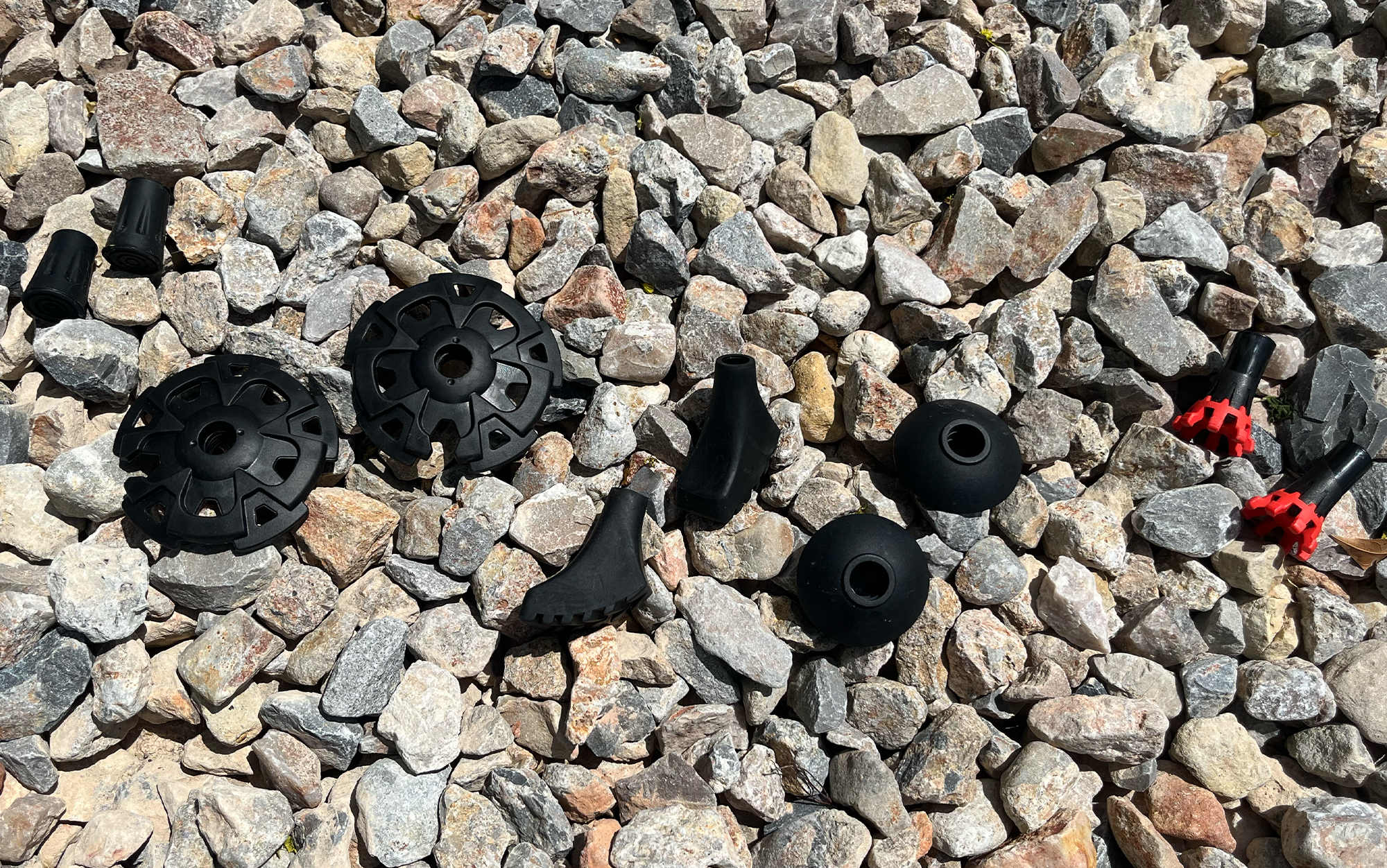
Small rubber tips will come already on the poles, but take these off before your hike. Snow baskets are larger than trekking baskets and they stop your pole from sinking into snow to give you more purchase and stability. Trekking baskets are smaller so they don’t get caught on things but still stop your pole from sinking into sand, mud, or rock crevices. They’re great for travel, storage, or pavement, but the metal tips are designed to give you optimal traction. Some also include rubber boot tips for slick rock or pavement.
TSL included a new tip called the crossover with both of their poles with eight grippy feet. If you hate when the pointed tip of your trekking pole skids or slips while trying to leverage yourself through an obstacle, then you’ll love these. They settle on top of gravel and loose rock well and would be great on ice. However, they do slightly increase the length of your pole so I made a micro adjustment to shorten mine when using the crossover.
Aluminum versus Carbon Fiber
Aluminum is highly durable, but heavier than carbon fiber. Carbon fiber is the lighter option, with a lot of strength, but they are more rigid and typically more expensive. Aluminum can corrode without proper care while carbon fiber is very corrosion resistant. There are trade offs for each material, but if you’re cutting ounces, opt for carbon fiber. And if you’re hard on gear or hiking in harsh conditions, aluminum is the stronger choice.
FAQs
Q: Do I really need trekking poles?
I tried to convert staff writer Laura Lancaster with some of the best trekking poles on the backpacking gear test, but failed to truly convince her to regularly pack two poles. She brings one trekking pole on some hikes when she knows there will be steep snow to traverse or a river crossing. Her argument is that since she typically uses the best minimalist shoes for hiking and backpacking (which emphasizes a forefoot strike over a heel strike which is more damaging to the knees), she doesn’t get as much benefit from the impact reduction of trekking poles.
However, if you want to save your joints and keep hiking into your 80s, then you should consider trekking poles. If you are already experiencing knee pain, plan on tackling rough or steep terrain, or struggle to keep up on hikes, then you should try a pair of the best trekking poles.
Q: What is the difference between hiking poles and trekking poles?
Hiking poles, hiking sticks, trekking poles, etc., they are all the same. A hiking staff is a longer, singular pole some hikers opt for. Some poles are better suited to running, hiking, or walking but it should be clear what activity your trekking poles are best suited for in the product description.
Q: Is it good to walk with trekking poles?
Yes. If you plan on taking a long walk and suffer from joint pain, trekking poles can provide extra support and relief. If you plan to walk on pavement, try rubber tip covers to avoid dulling the traction on the metal tips.
Q: Do you need 1 or 2 hiking poles?
Plenty of people just bring one trekking pole in case they need it or hit a fast-running river or steep pass. Some ultralight tents only need one pole for construction, so this can be extra weight savings. However, if you plan to consistently use trekking poles, I would bring both. Working just one side of your body will start to feel tiresome and for more relief and stability, two are better than one.
Why Trust Outdoor Life?
Since 1898, OL has been a leading authority in testing and reviewing hunting gear, fishing tackle, guns and shooting equipment, and much more. We have more than a century-long history of evaluating products, and we’re now bringing that expertise to online reviews. Our editors are experienced outdoorsmen and women, and most importantly, we’re trained journalists. We prioritize field testing and objective data when reviewing products. We conduct interviews with gear manufacturers and engineers as well as outdoor experts so that our readers have an understanding of how and why a product works—or doesn’t.
Advertising does not influence our gear reviews and it never will. While we always focus our coverage on standout products—because we want our readers to be aware of the latest and greatest gear—we also cover the flaws and quirks of any given product.
Final Thoughts
The best trekking poles can offer you joint relief, increased efficiency, and even decrease your perceived exertion. The lightest pair on this list are the Gossamer Gear LT5 Carbon trekking poles making them ideal for pitching an ultralight shelter. The overall best trekking poles are the Leki Makalu FX Carbon because they’re sturdy, balanced, and reliable. Regardless of what you plan to use your trekking poles for, you’ll find the right pair for you from this test.

